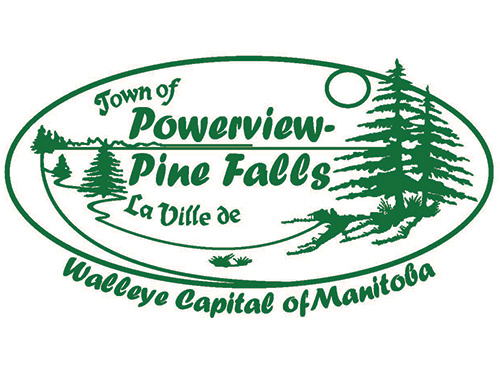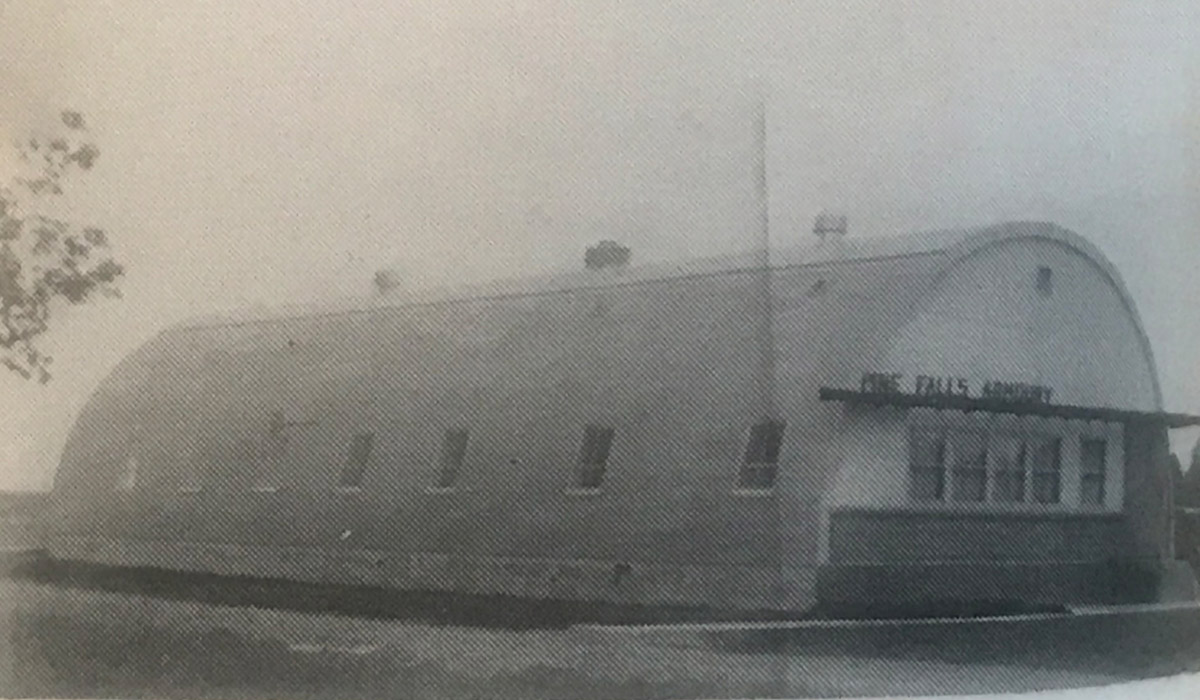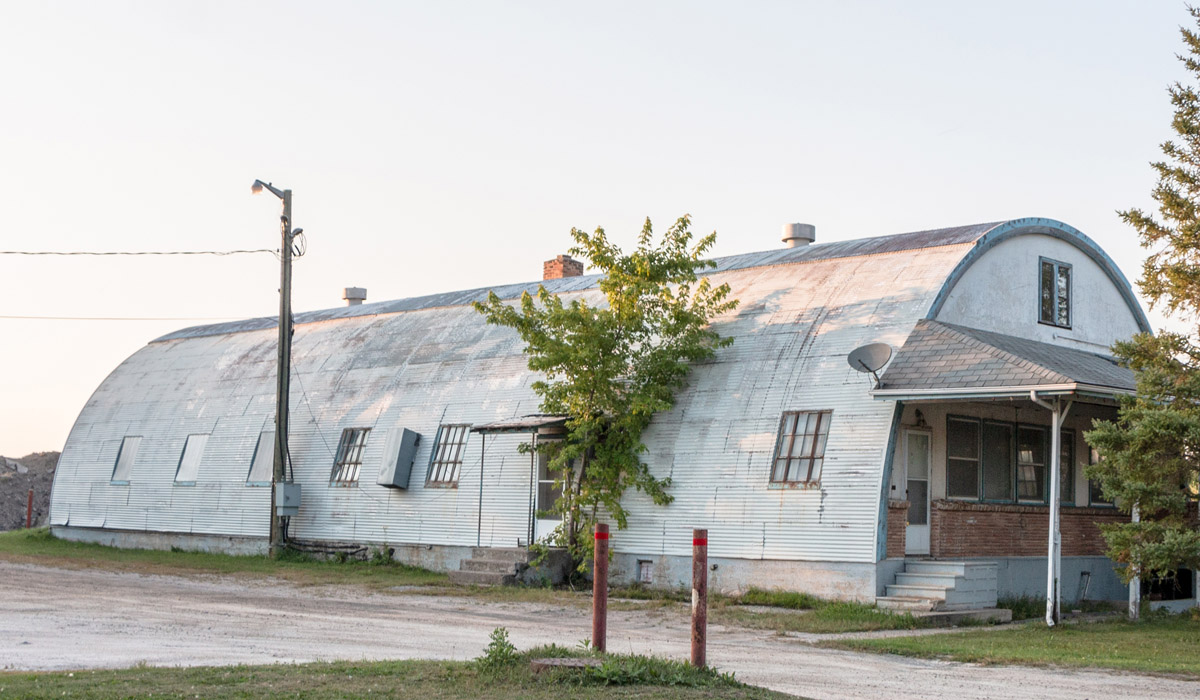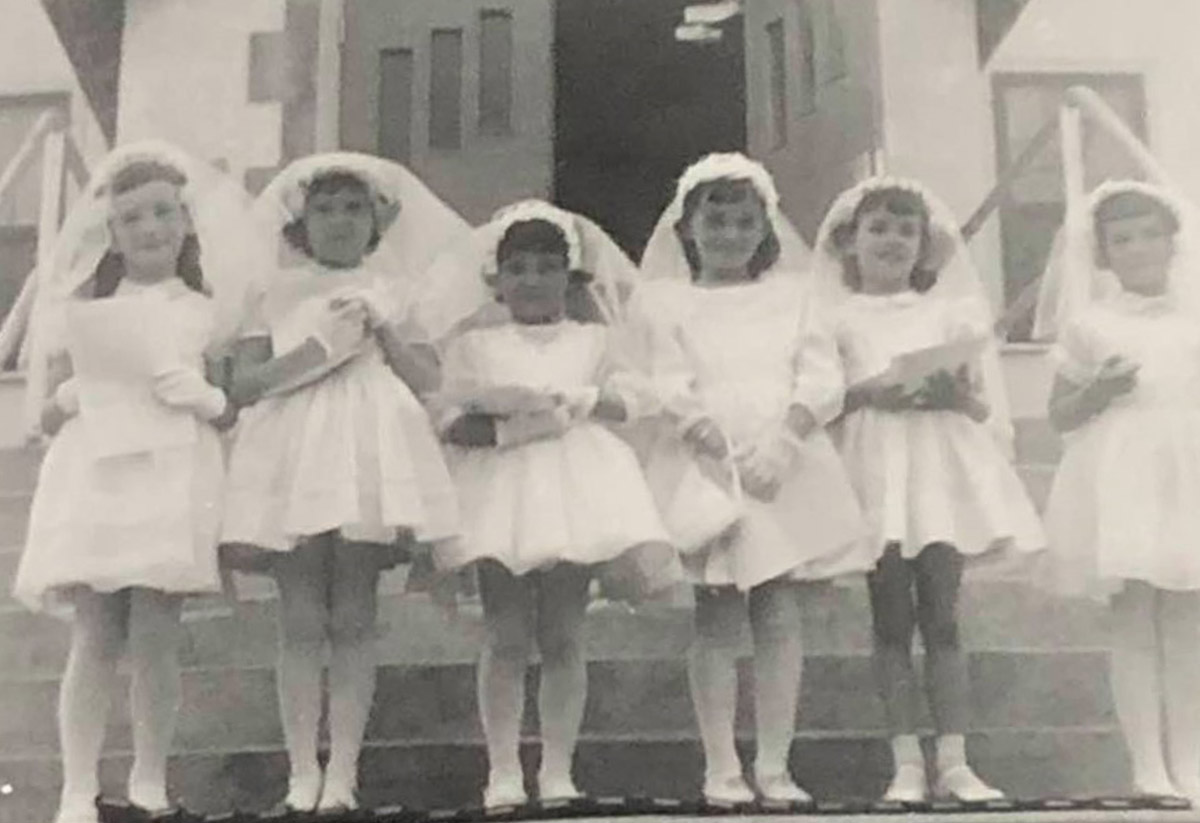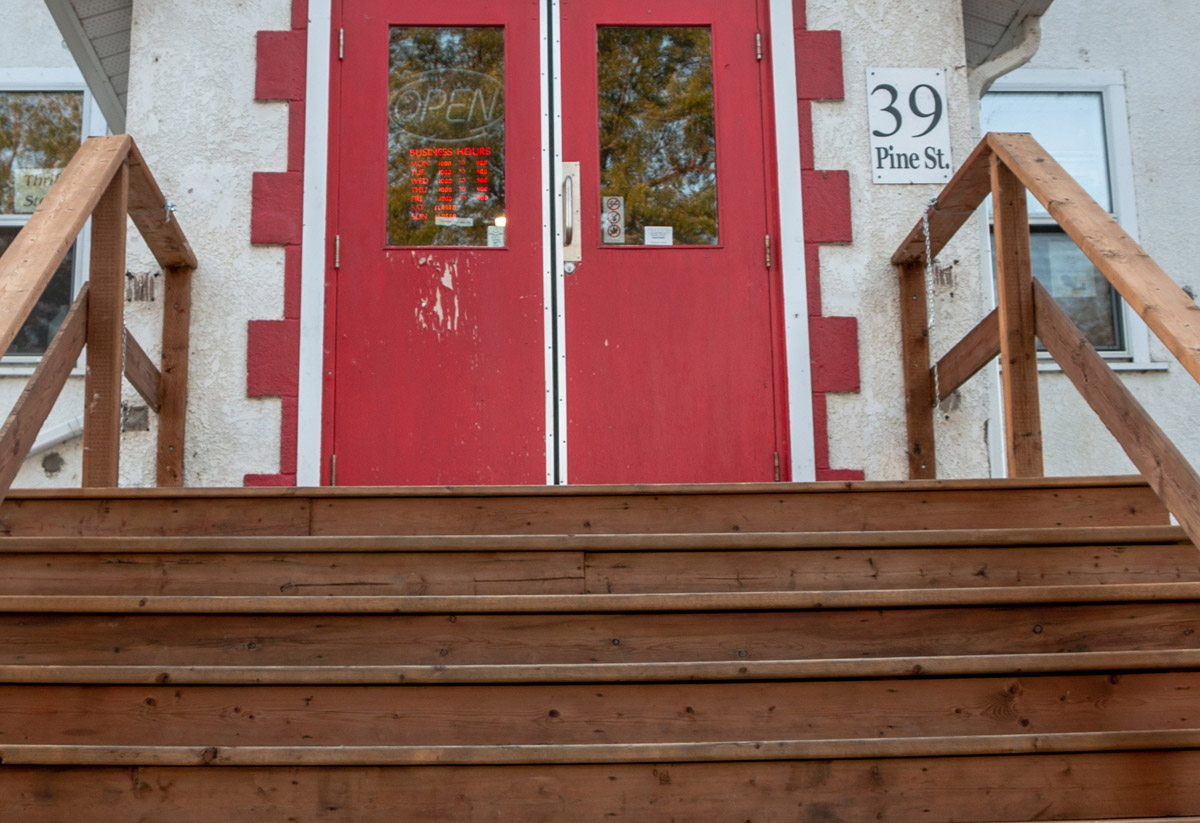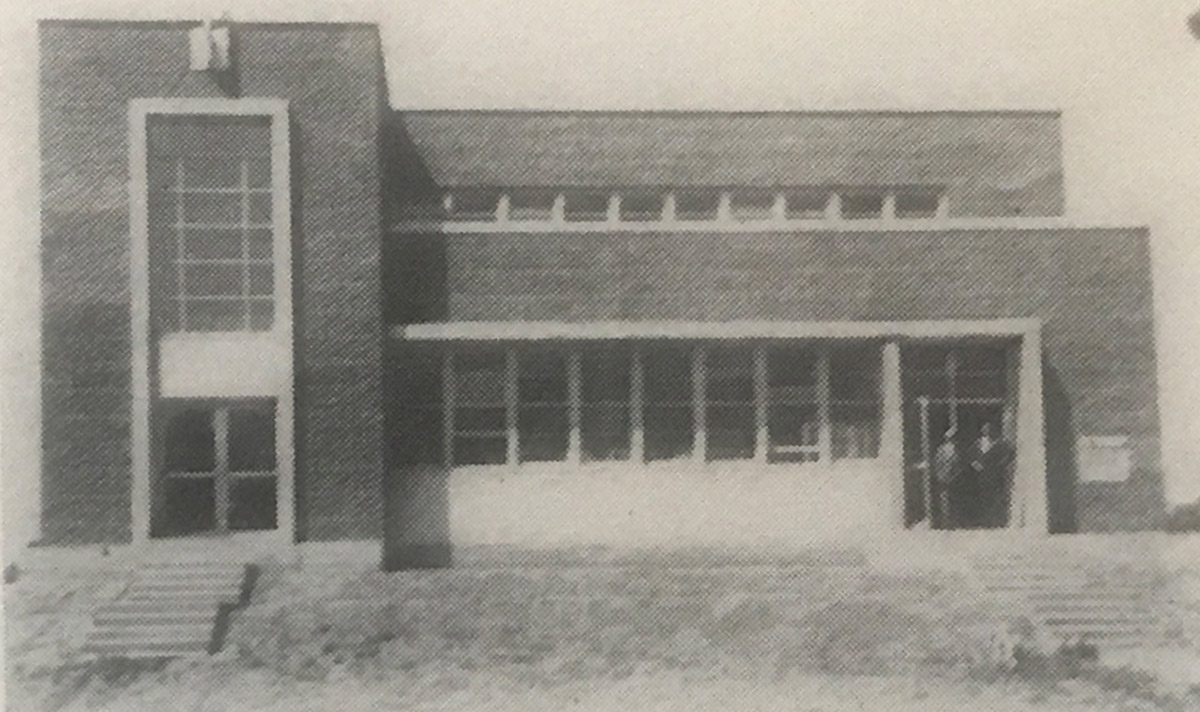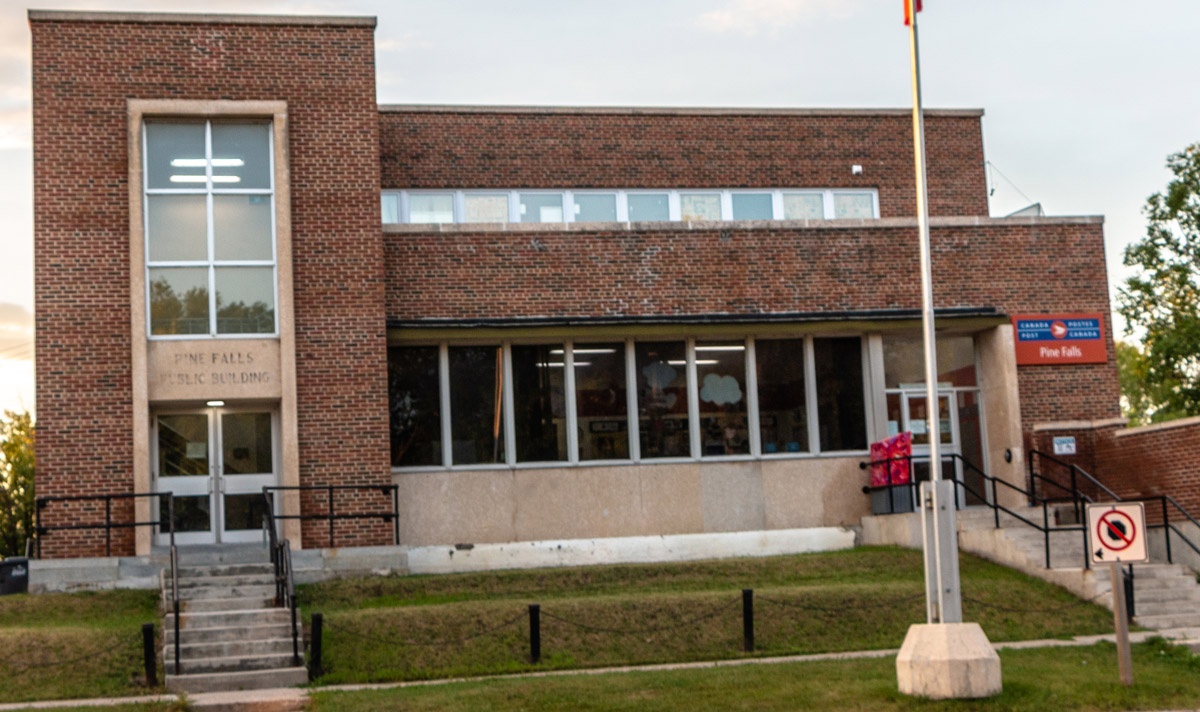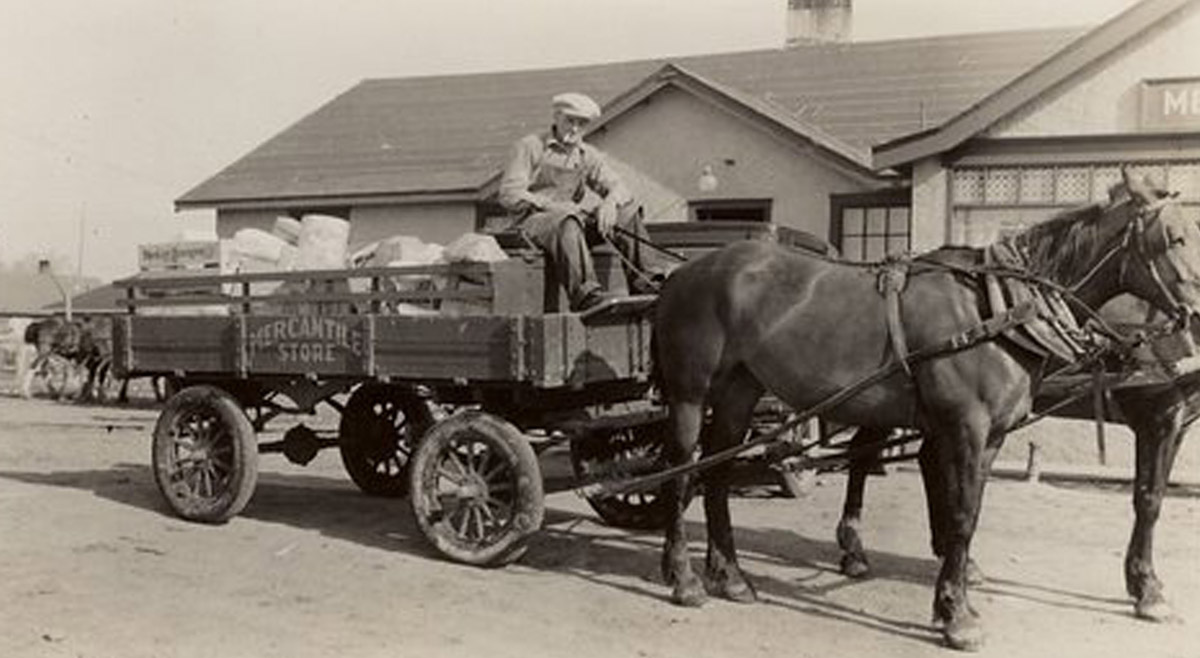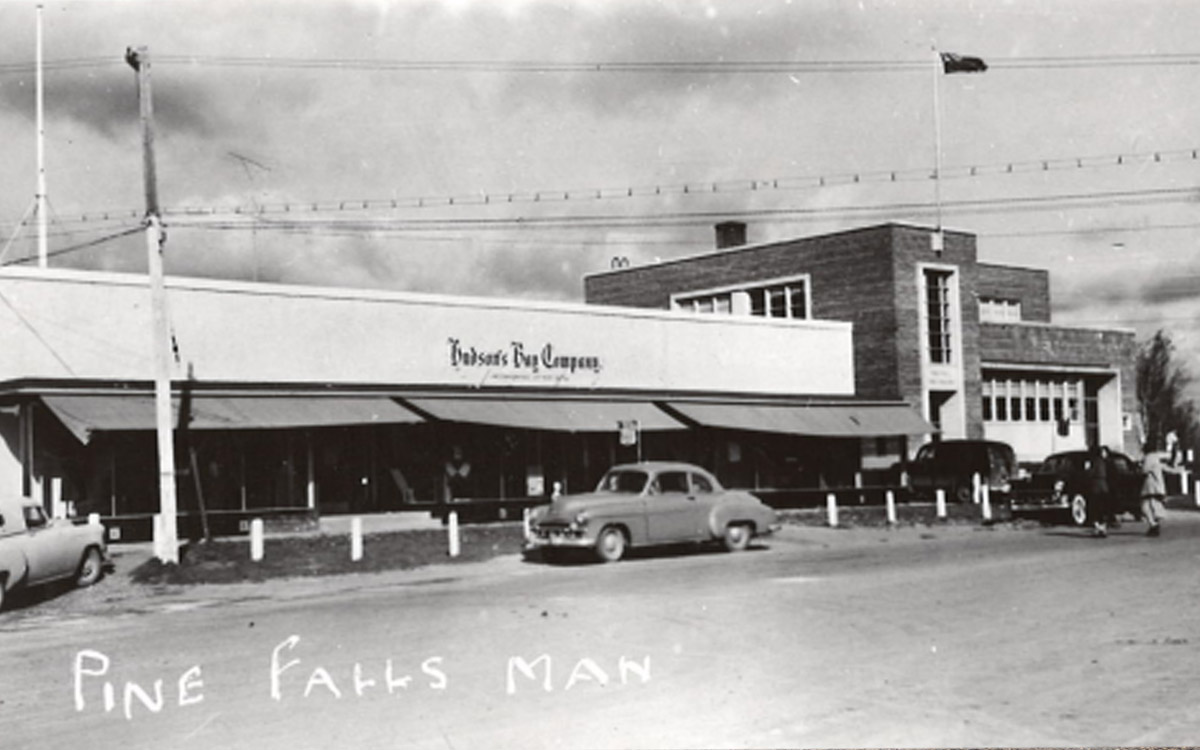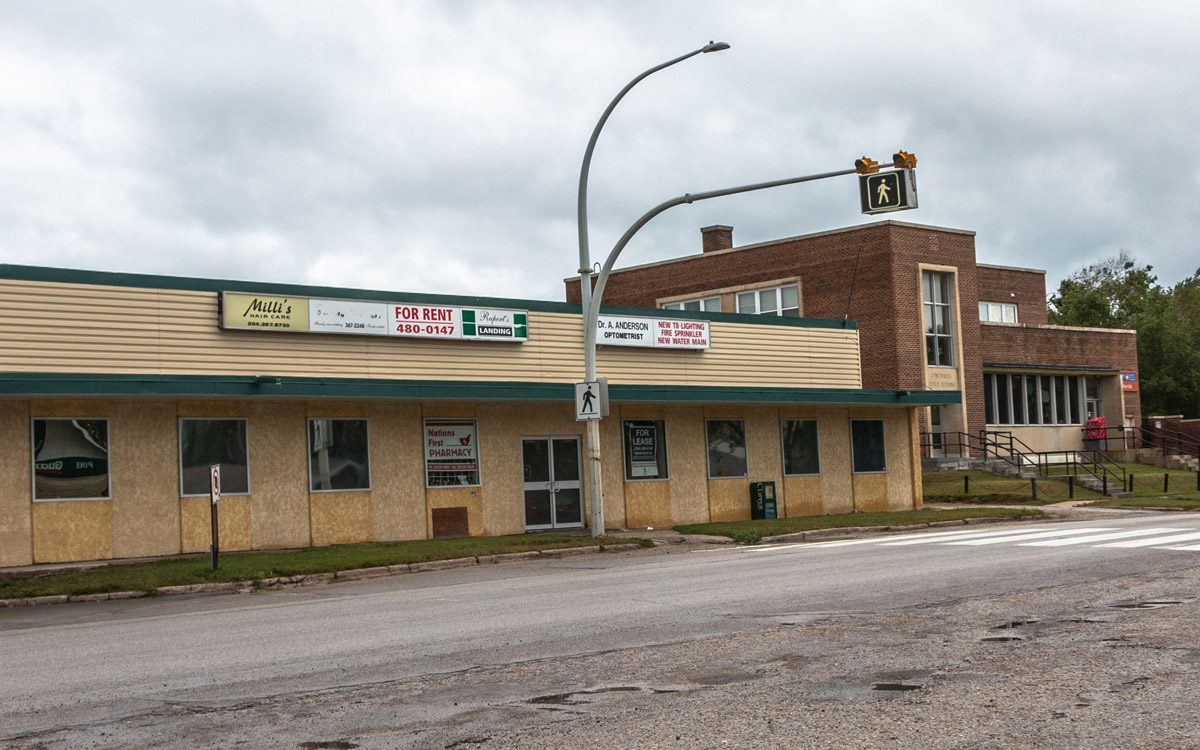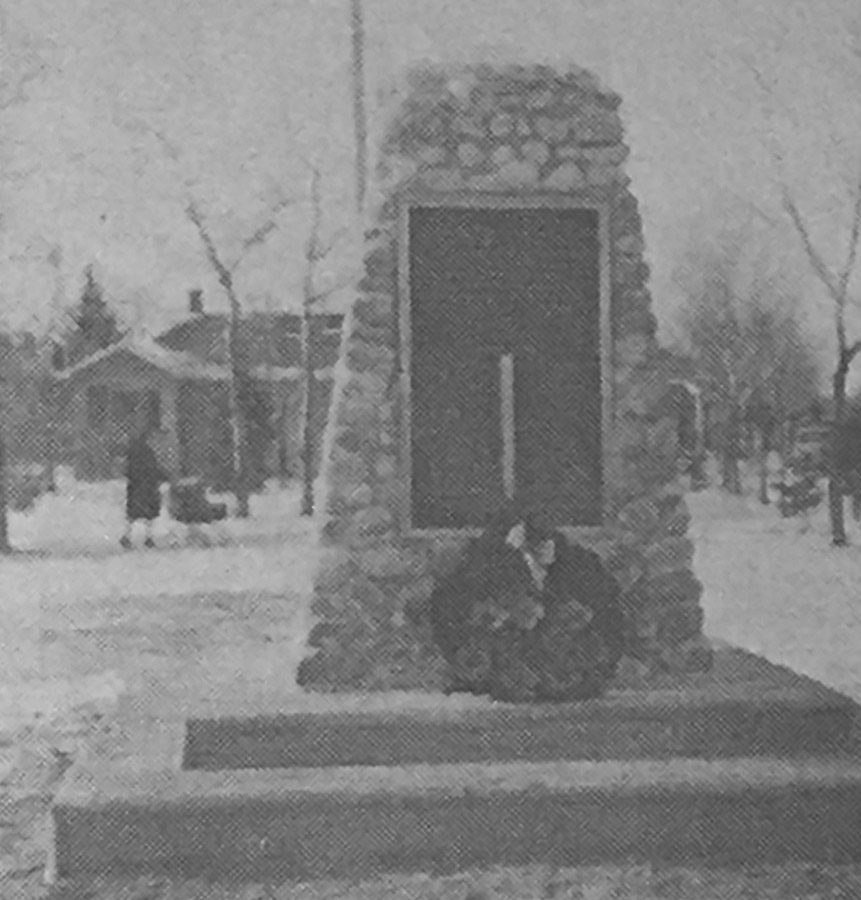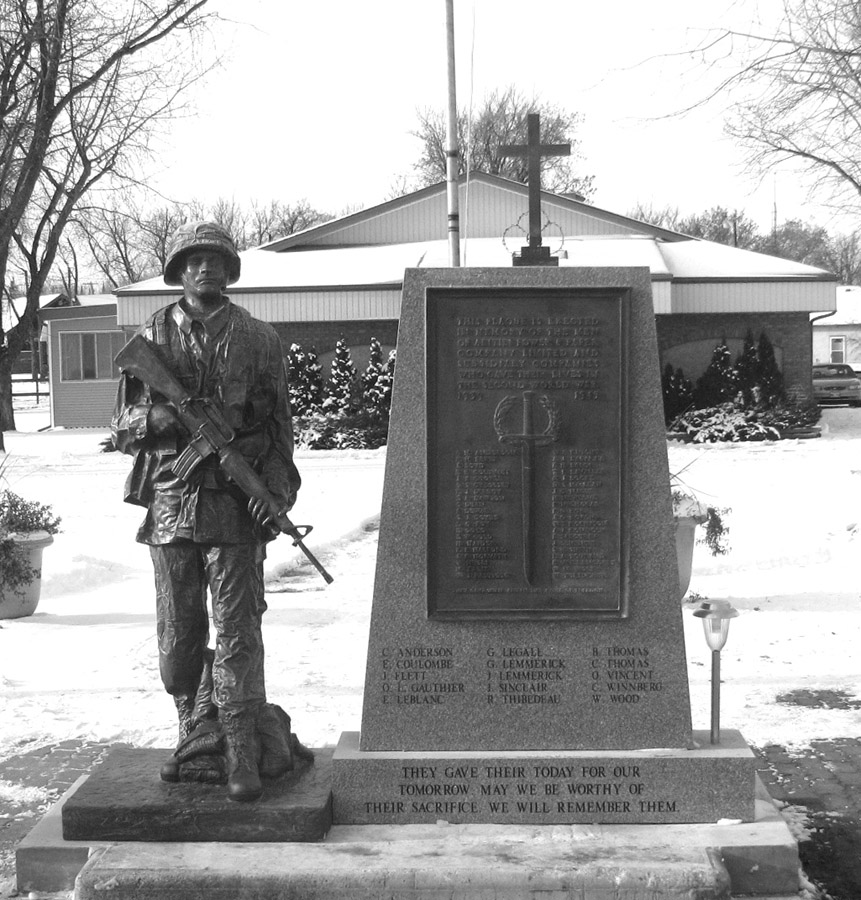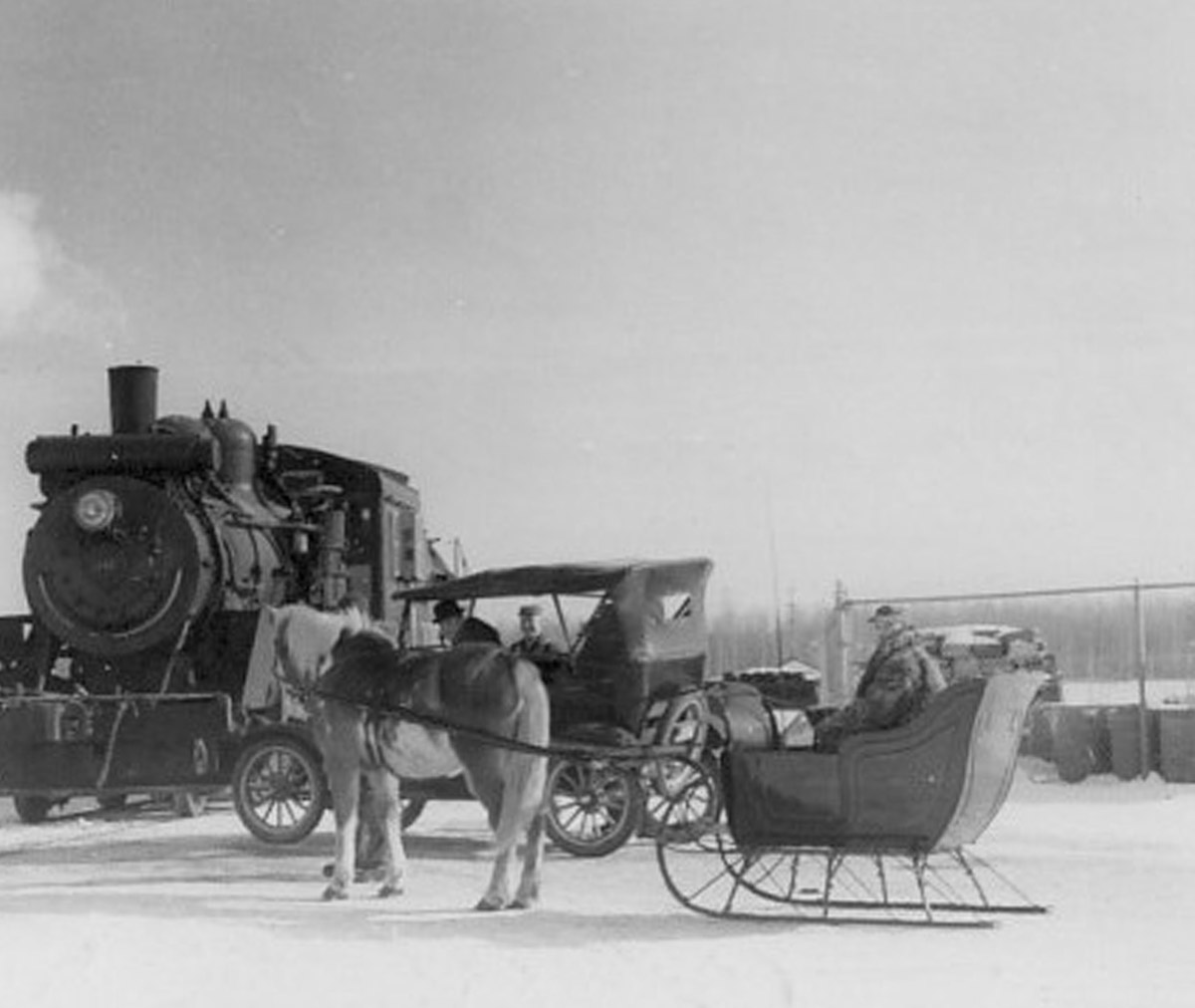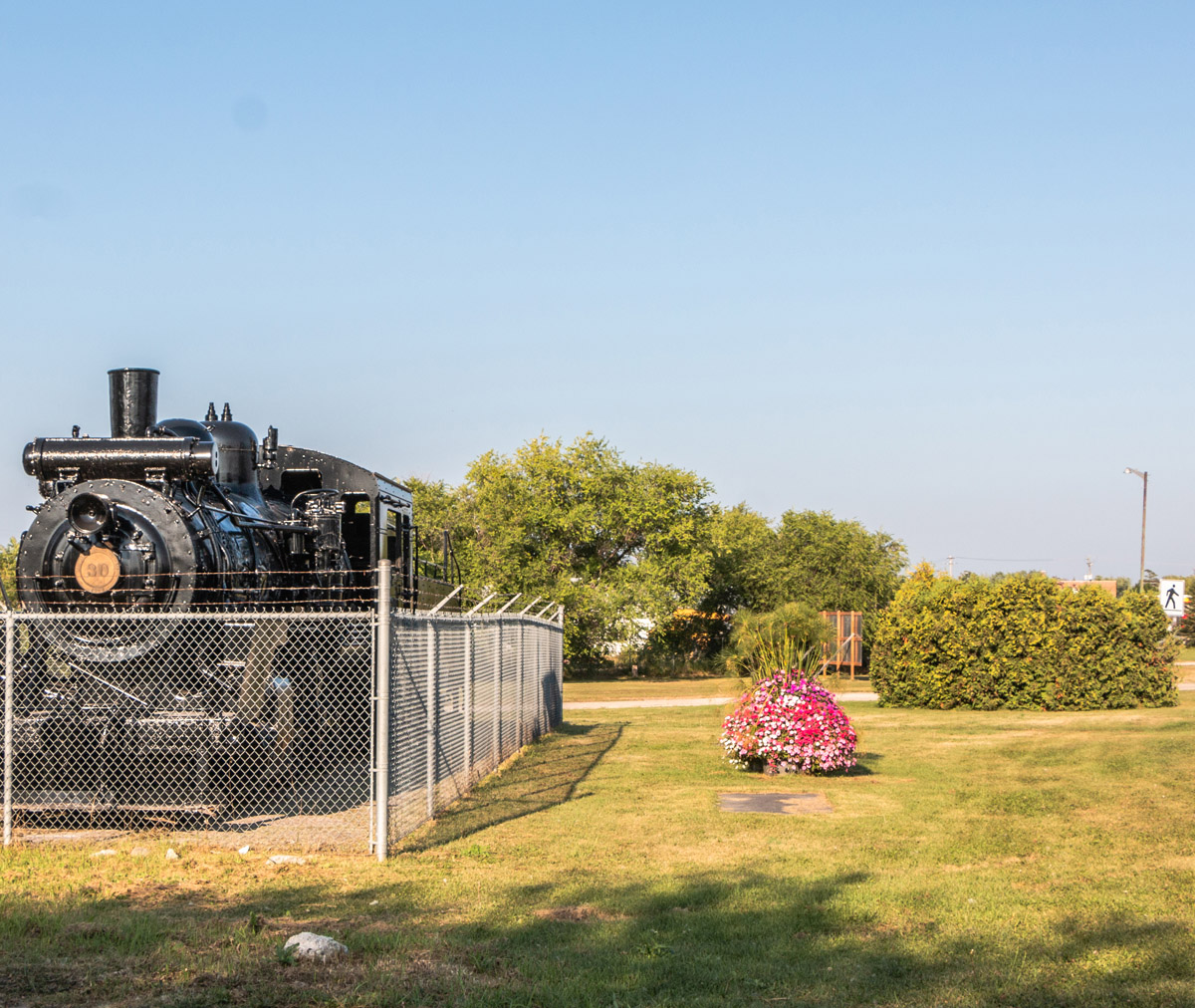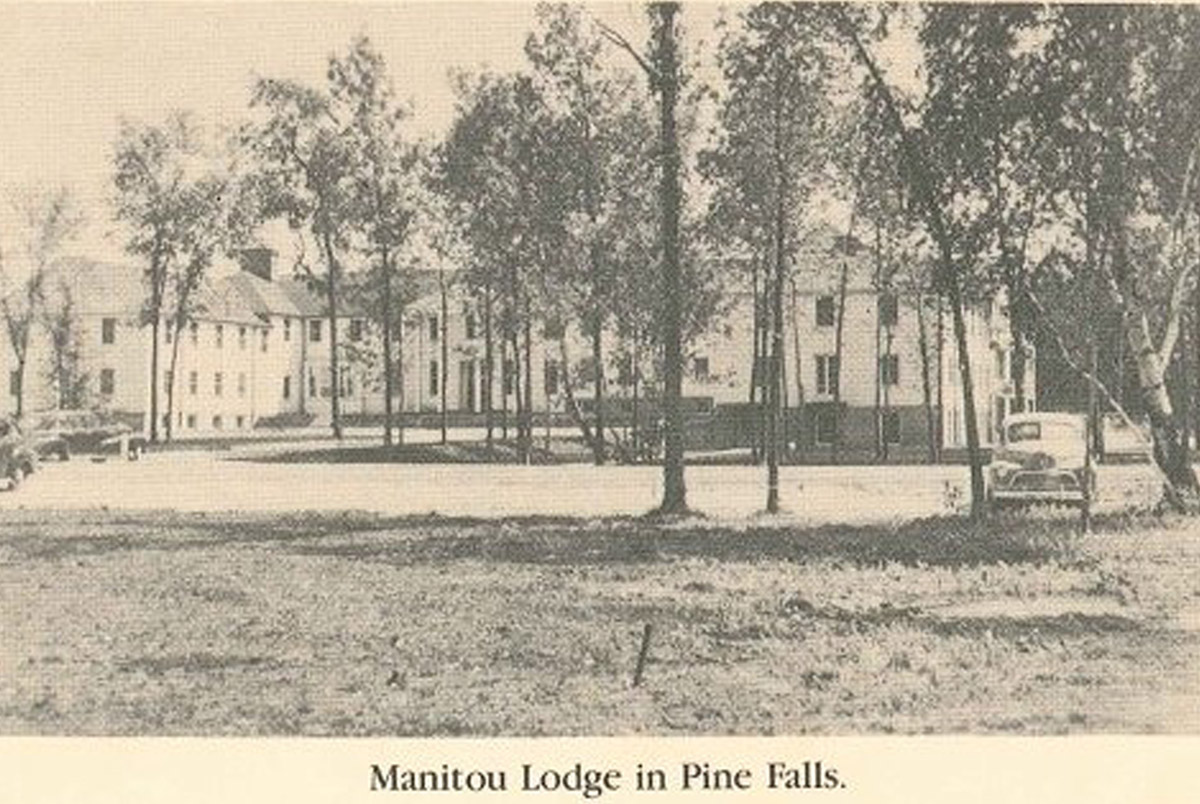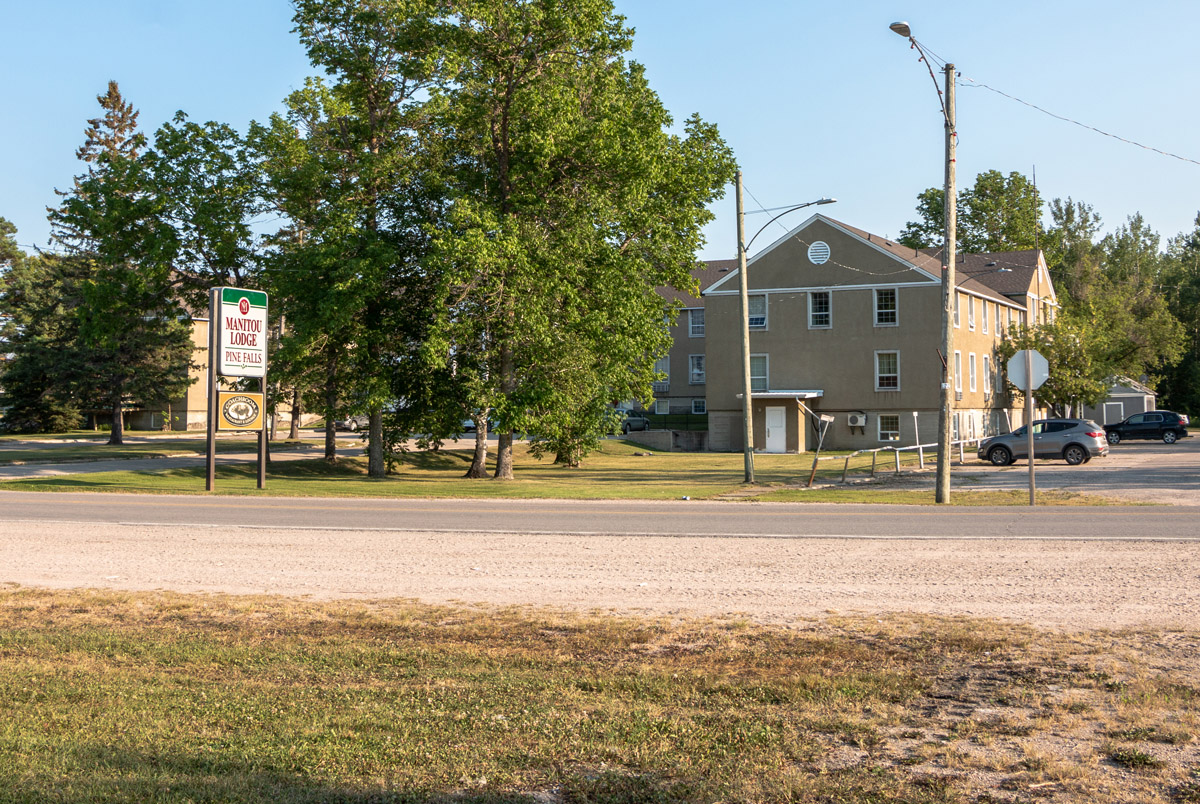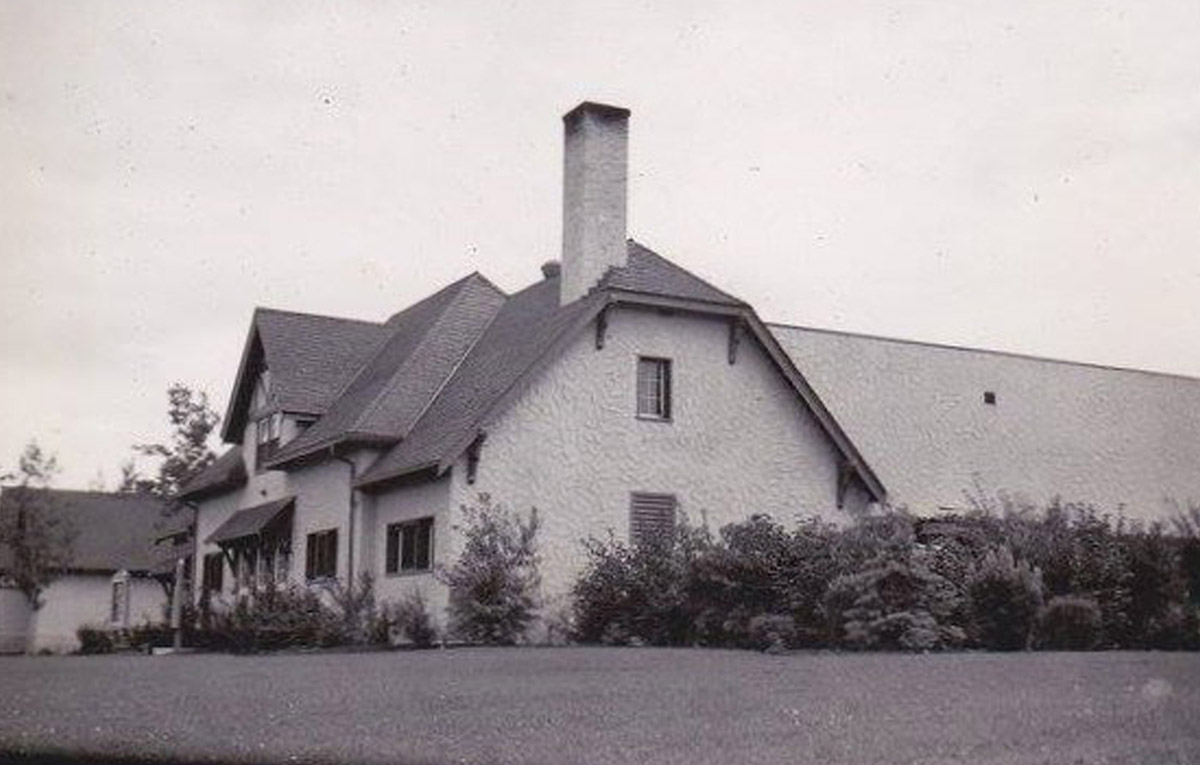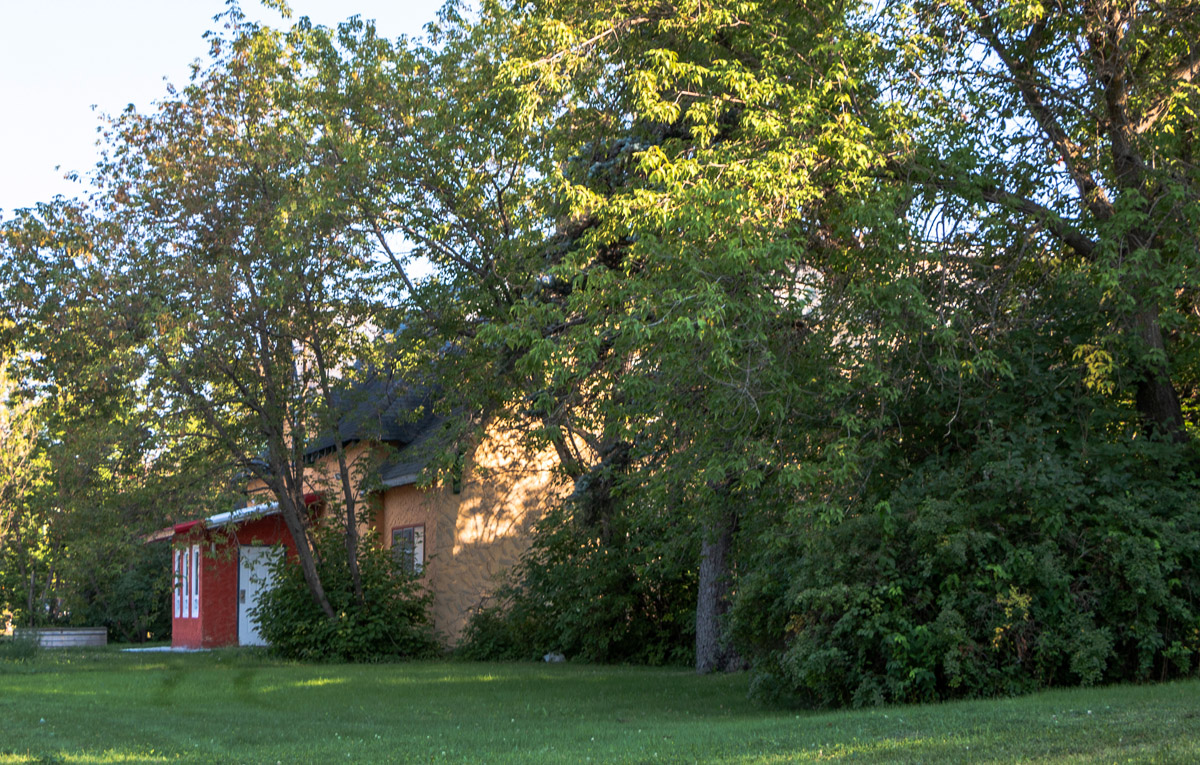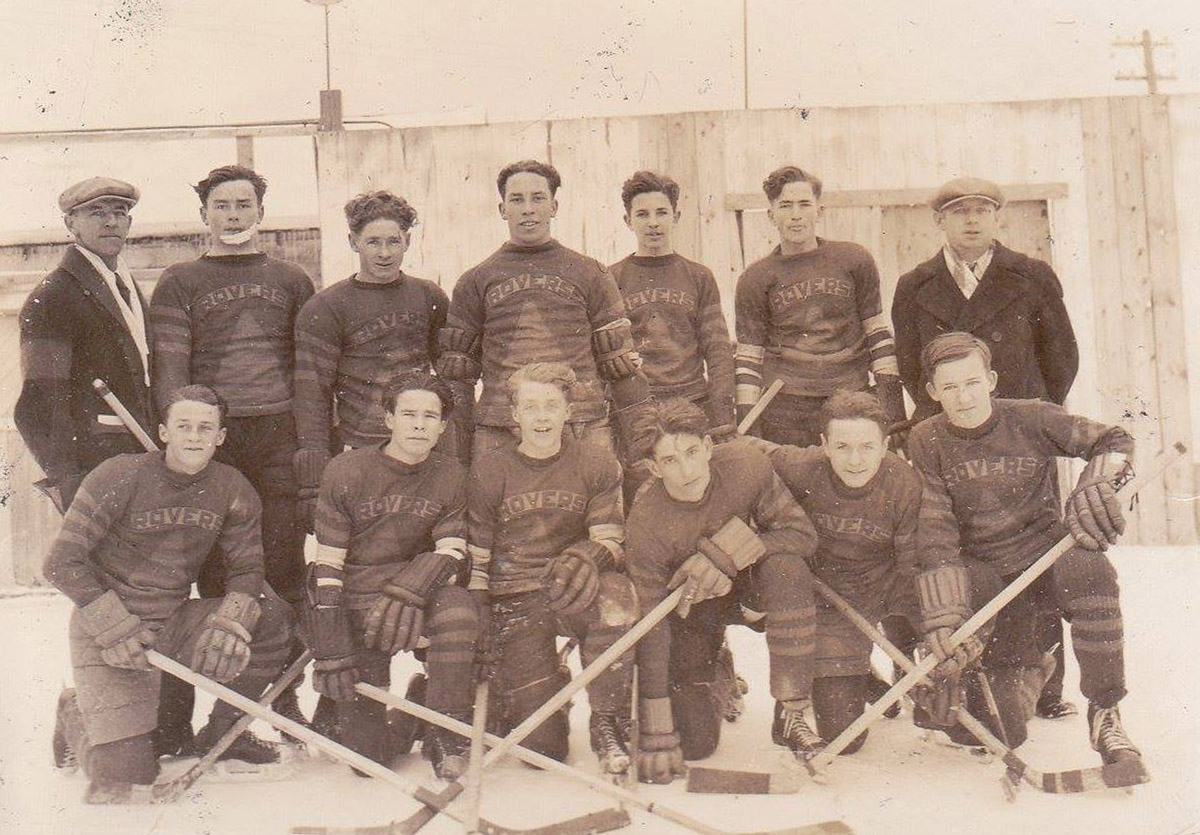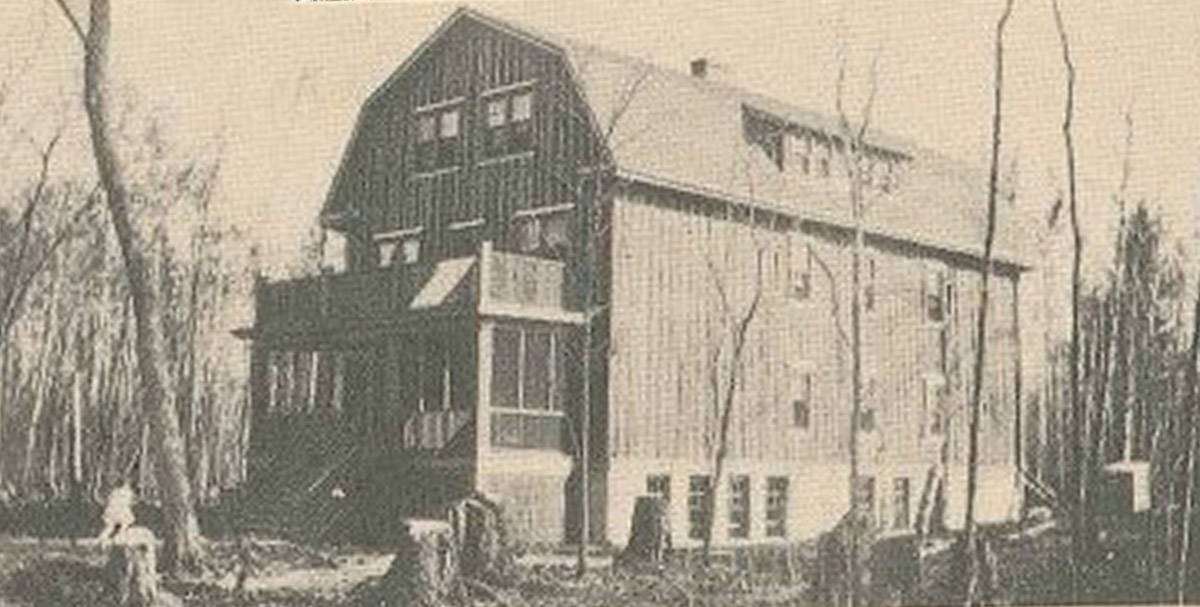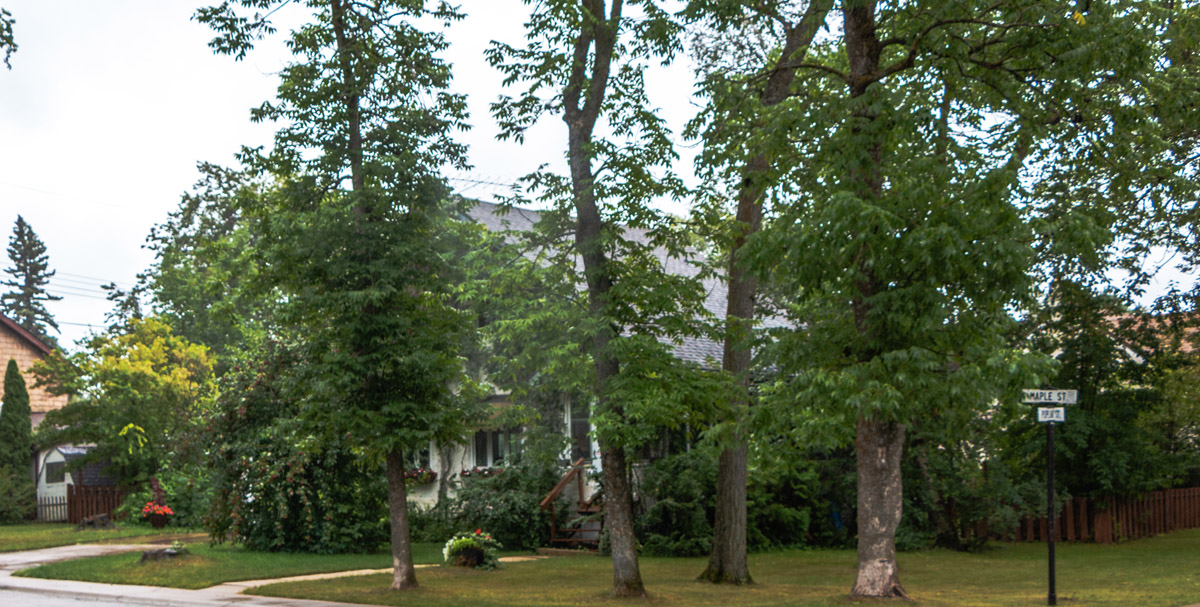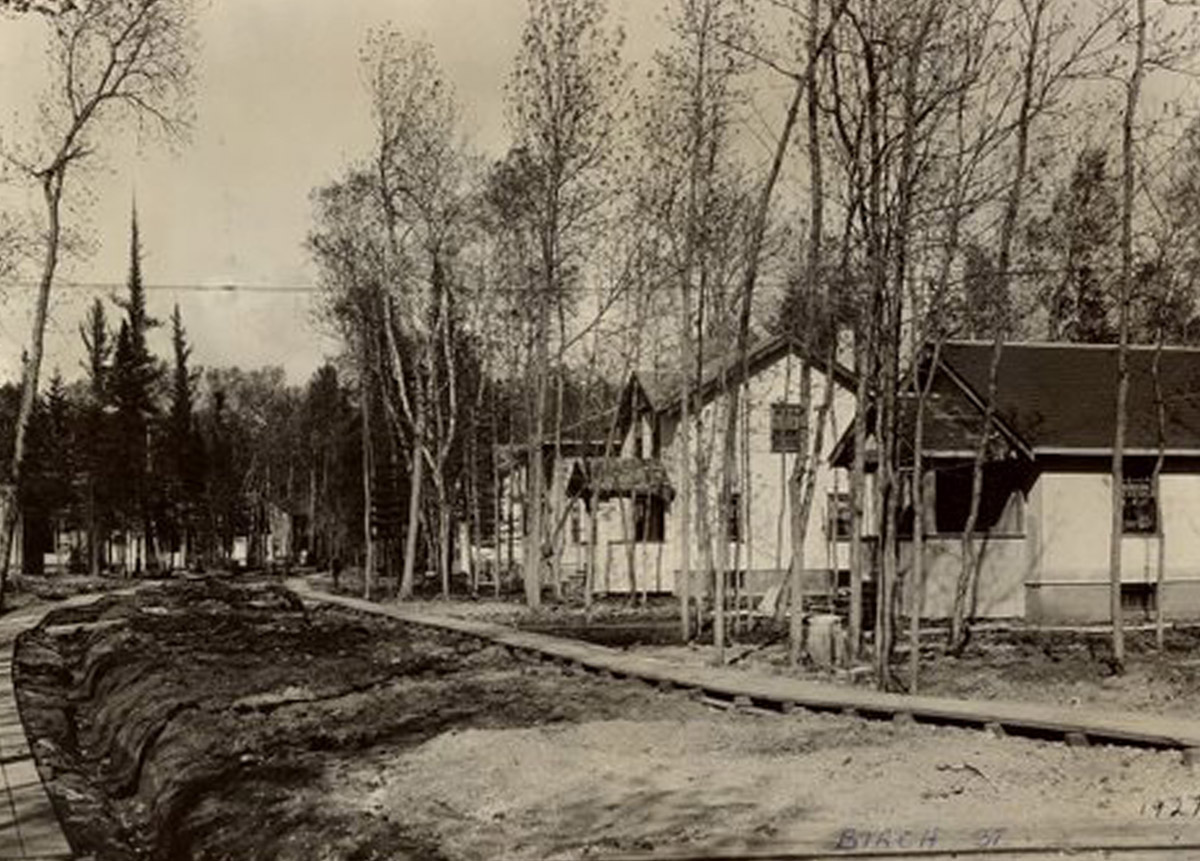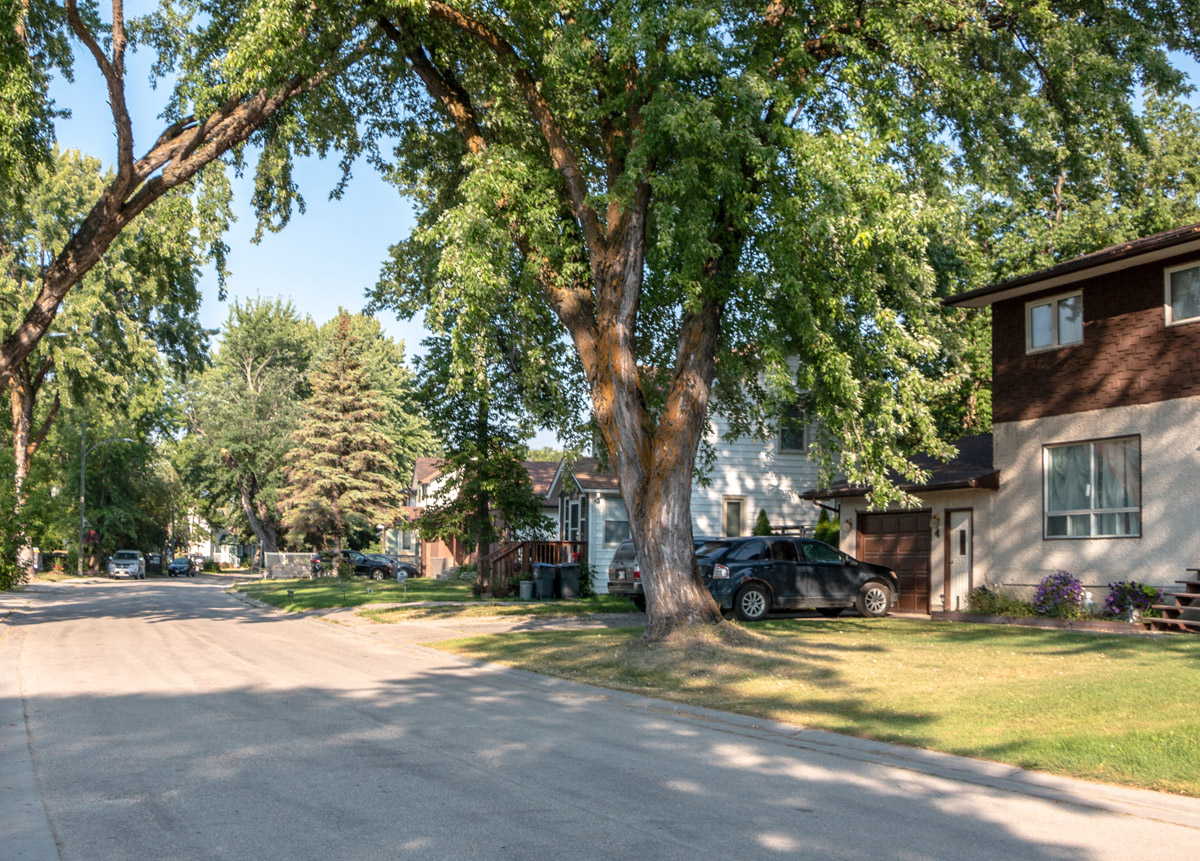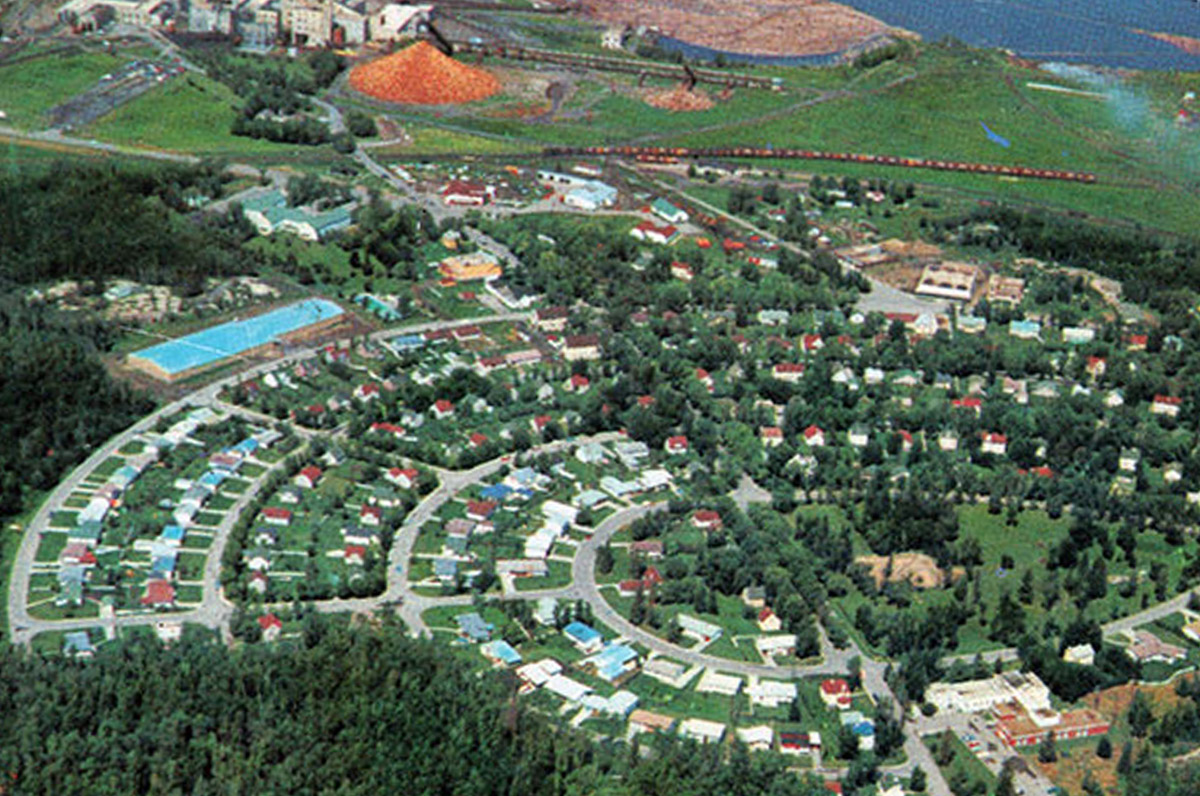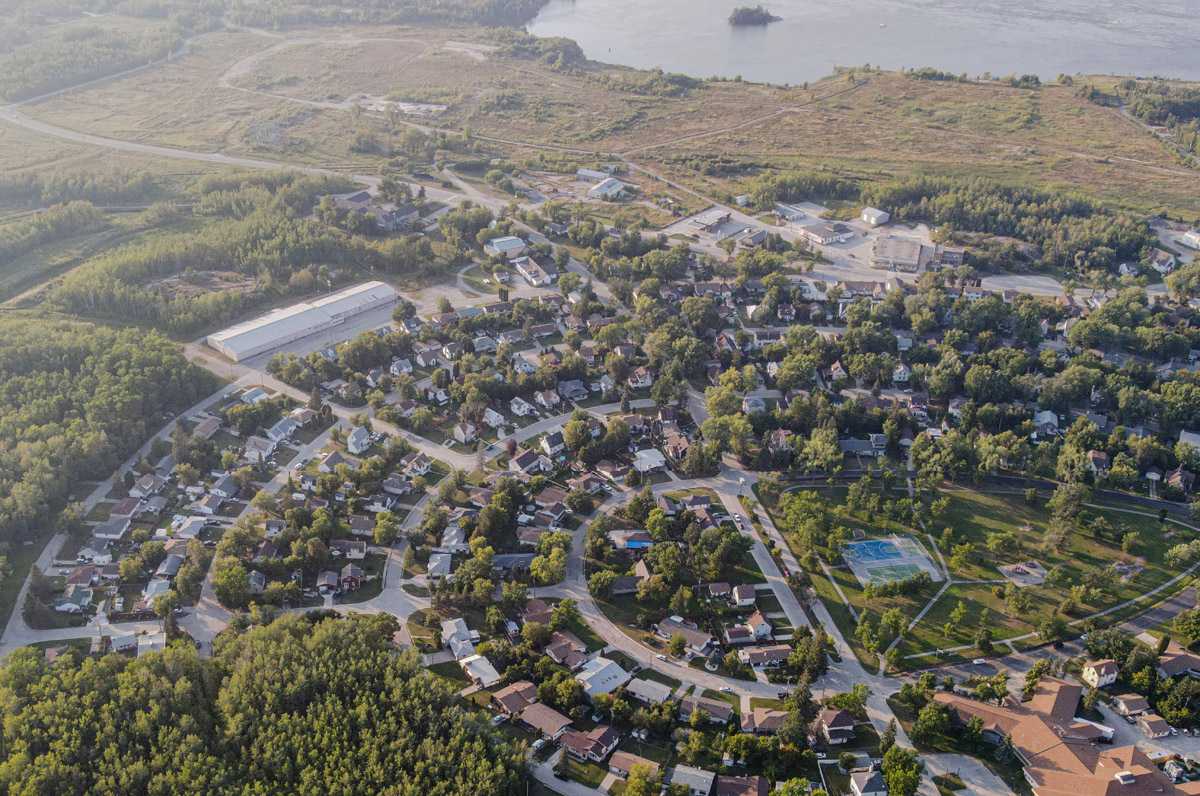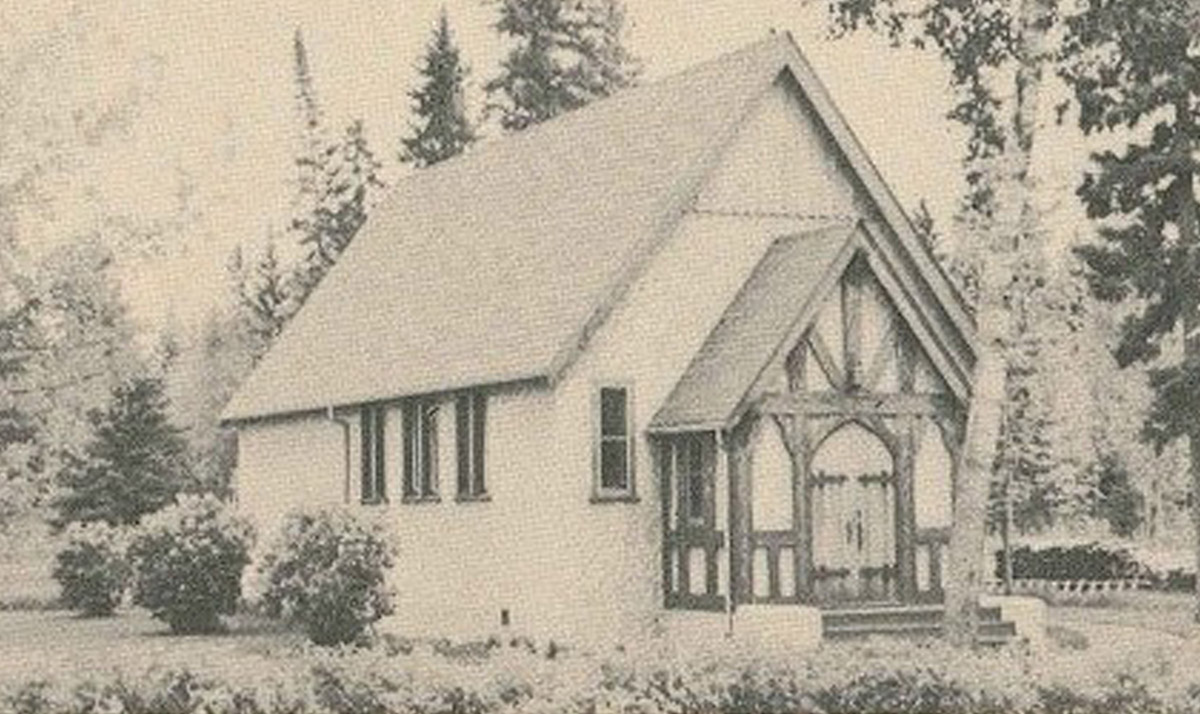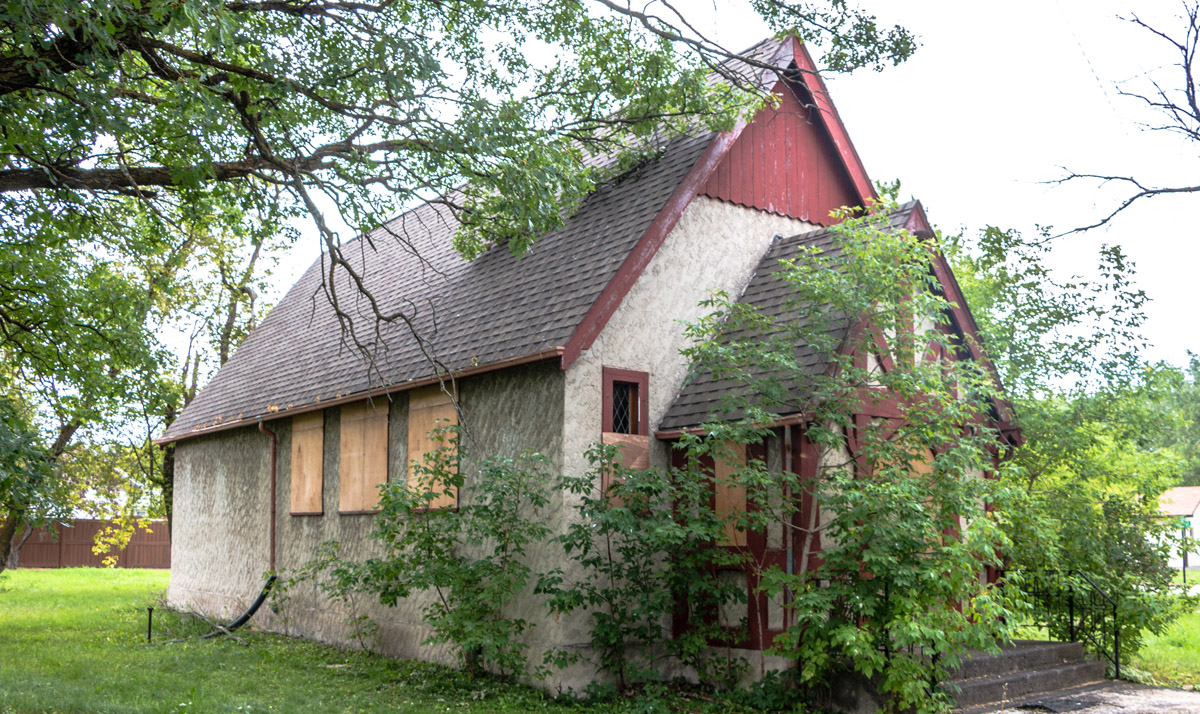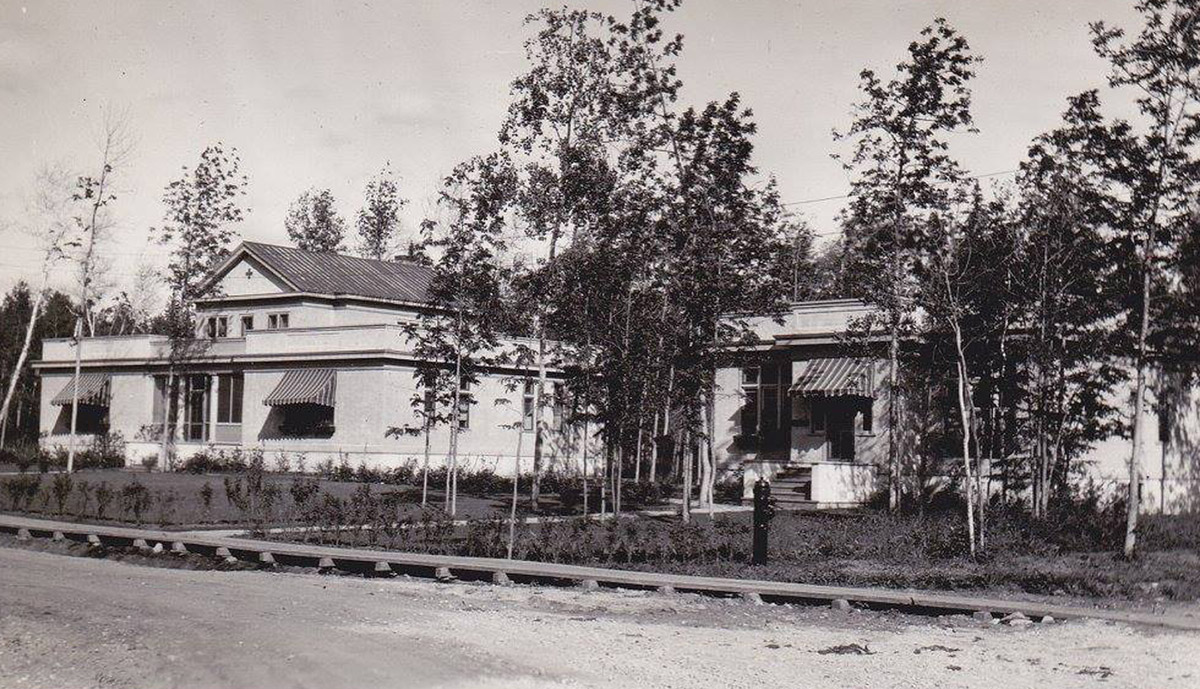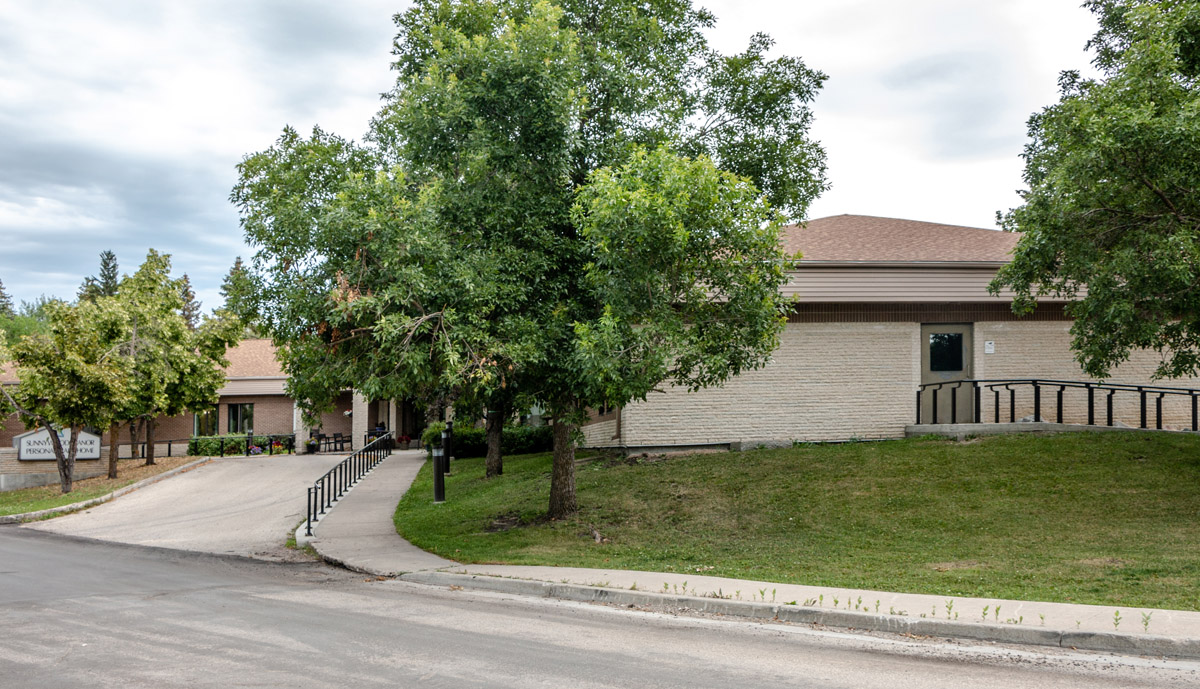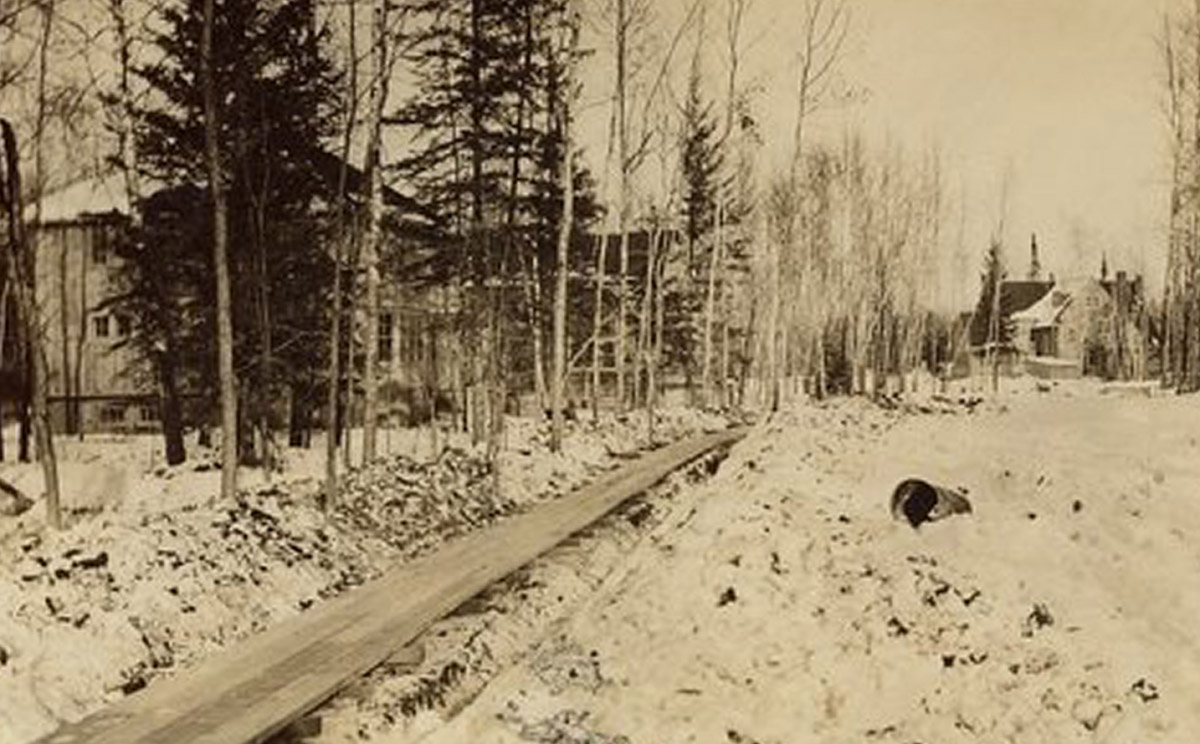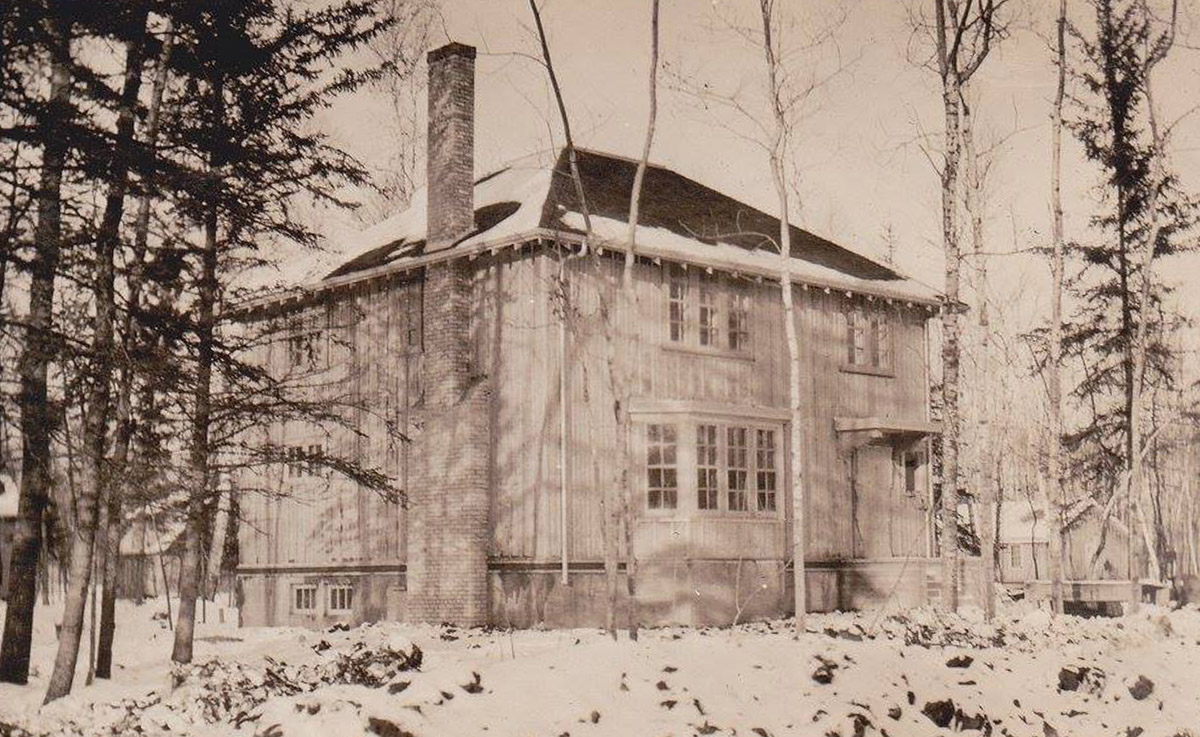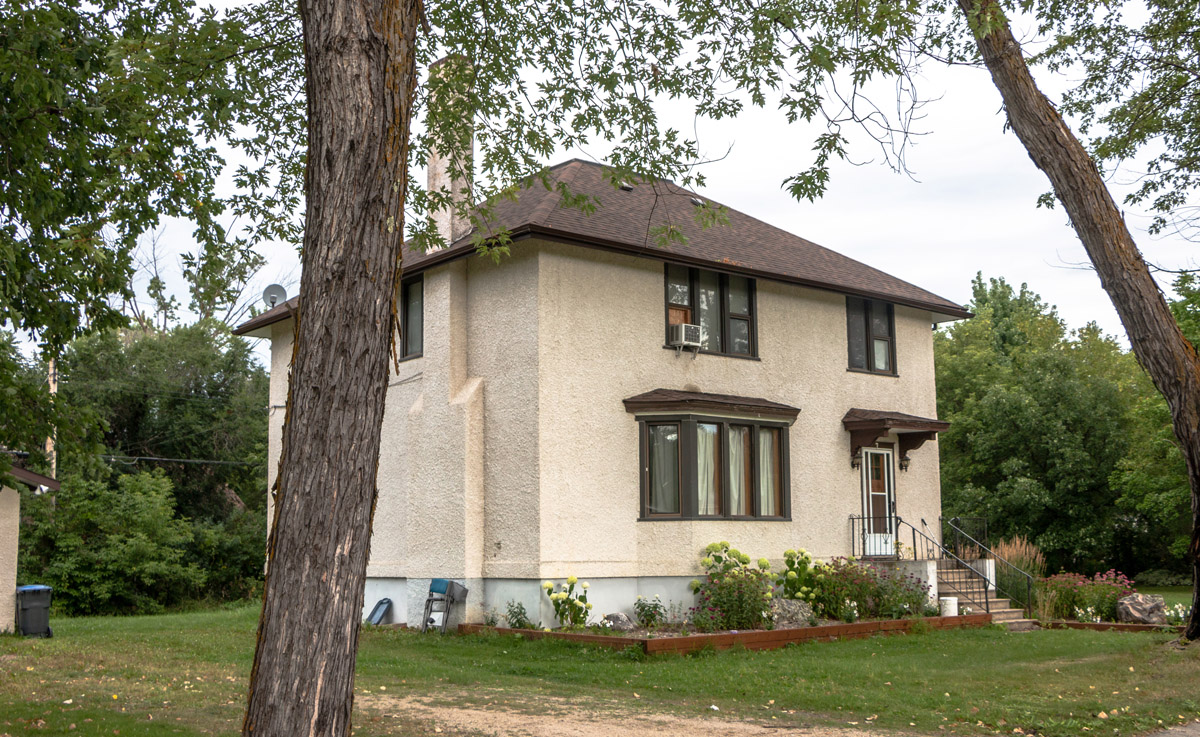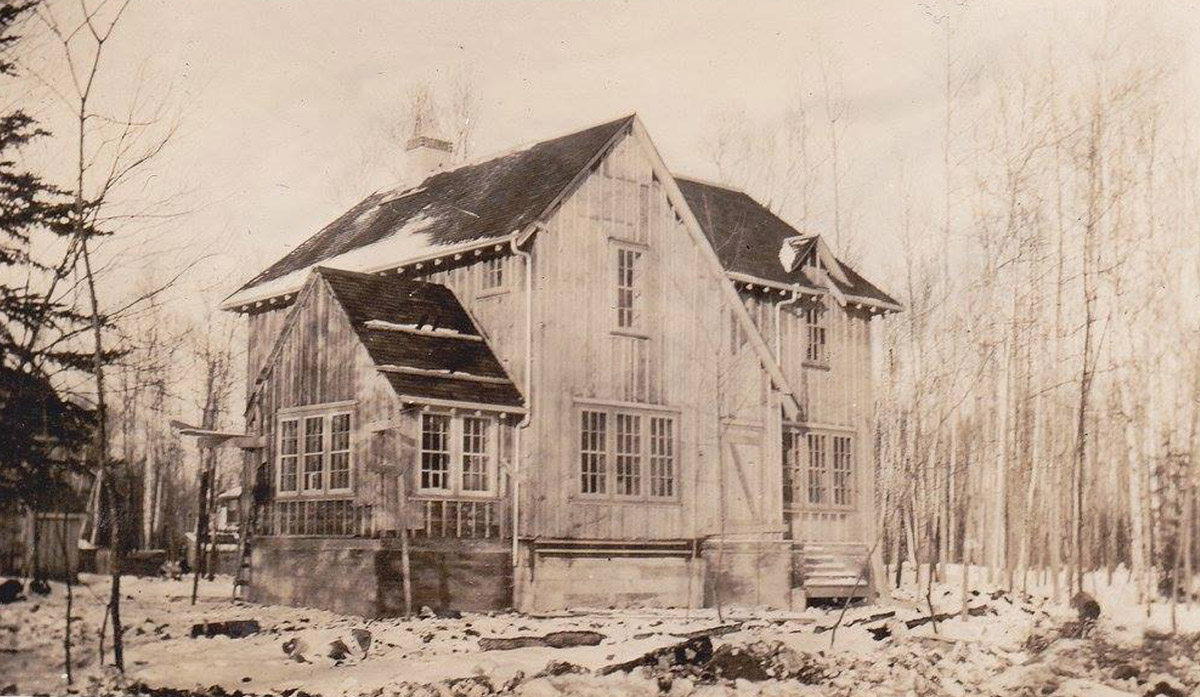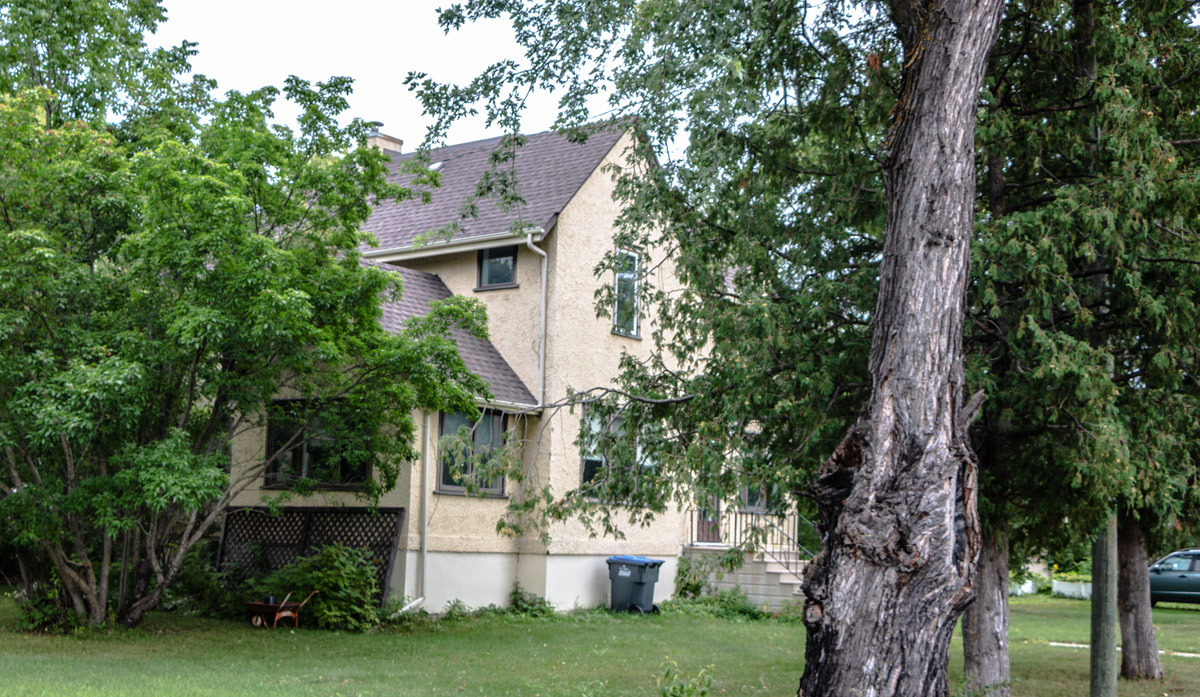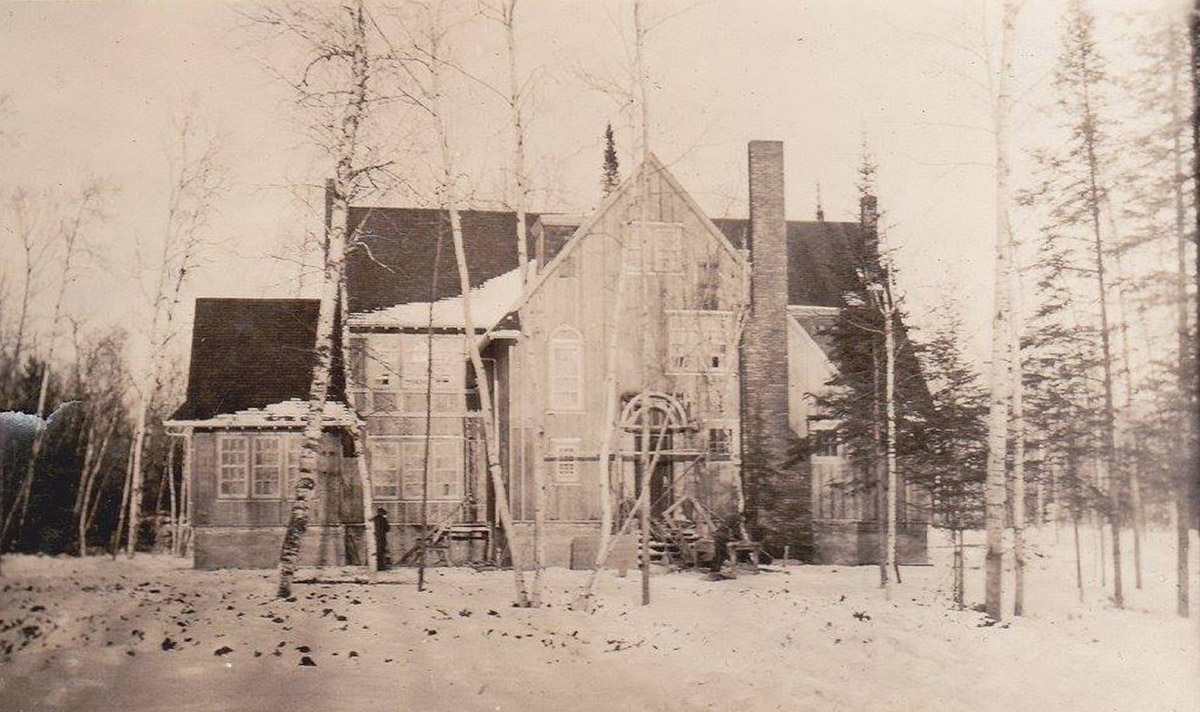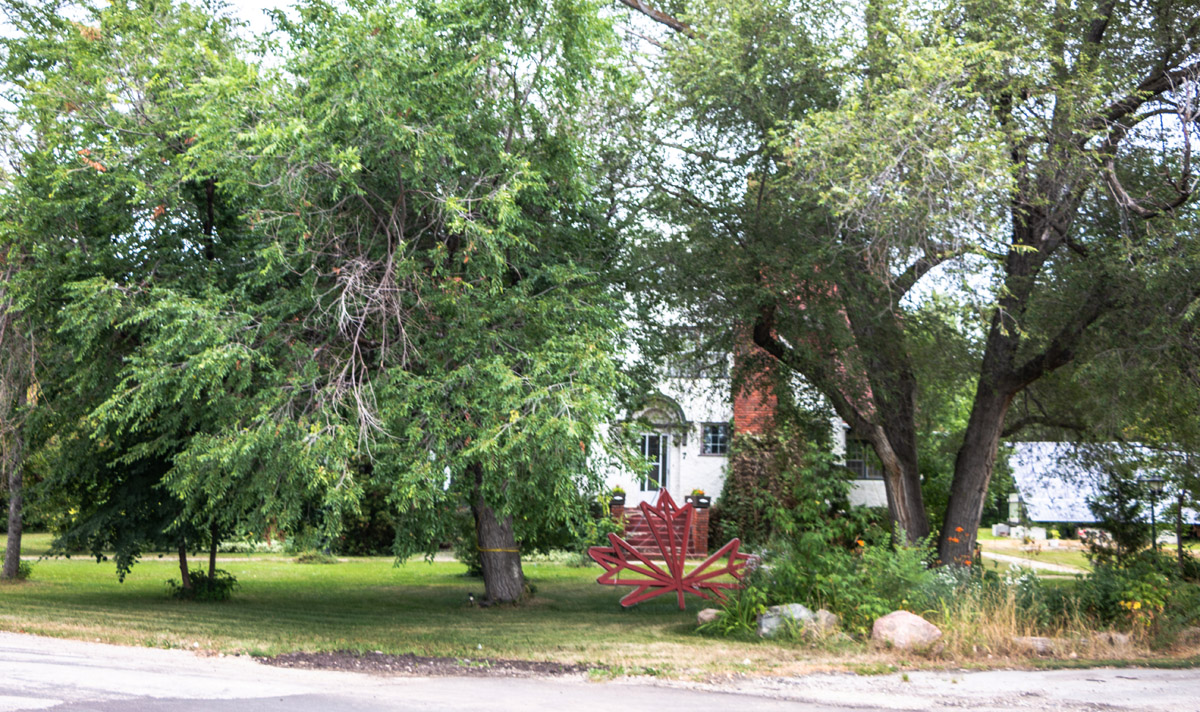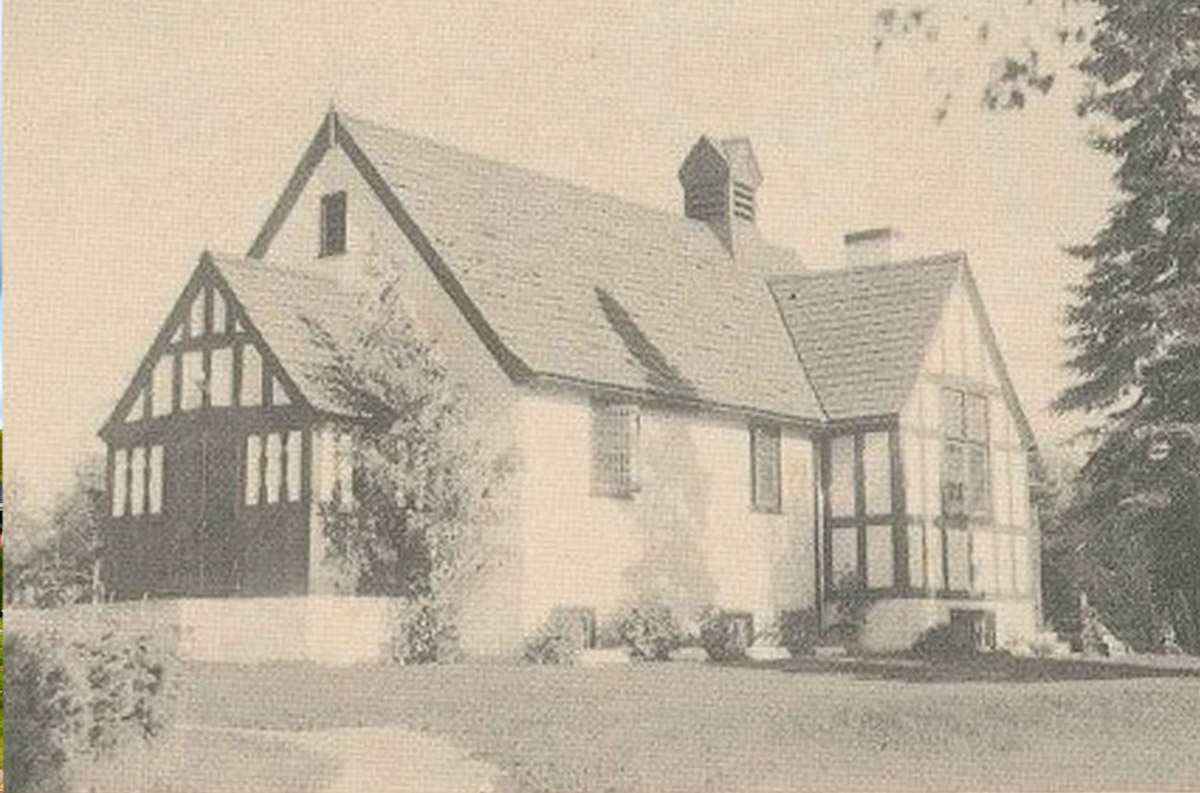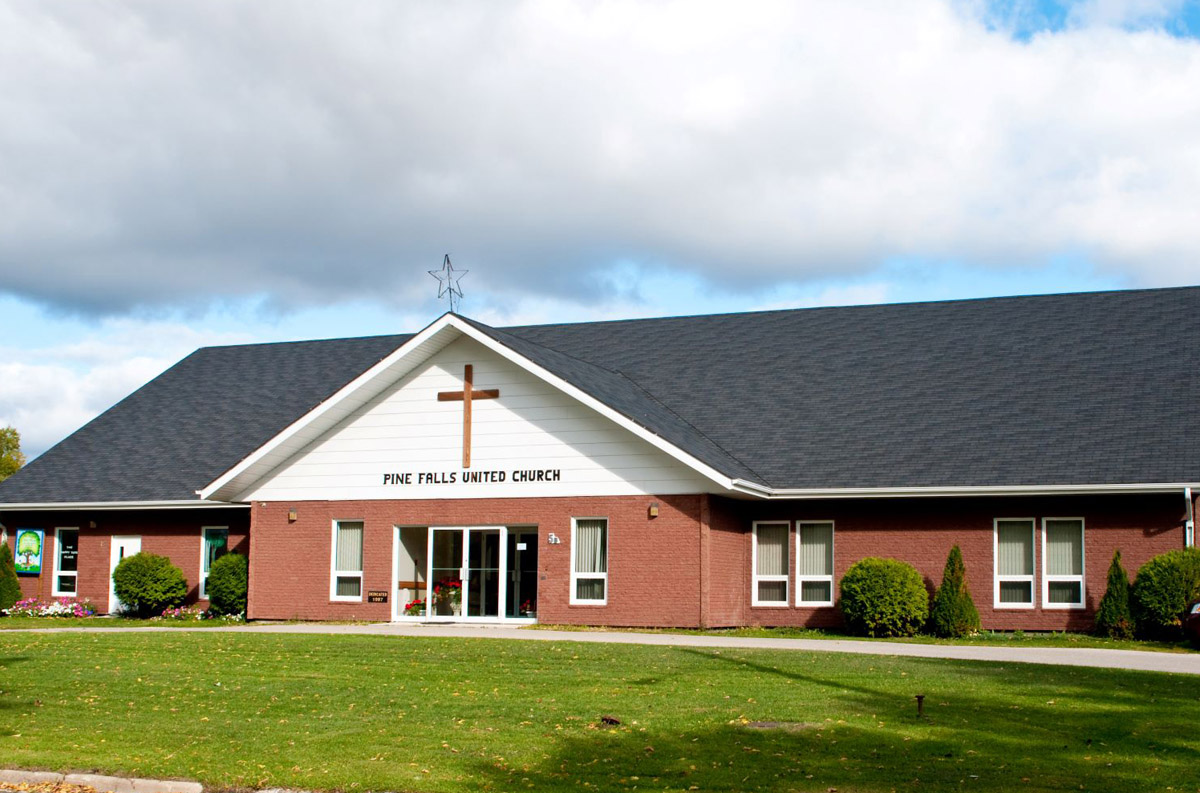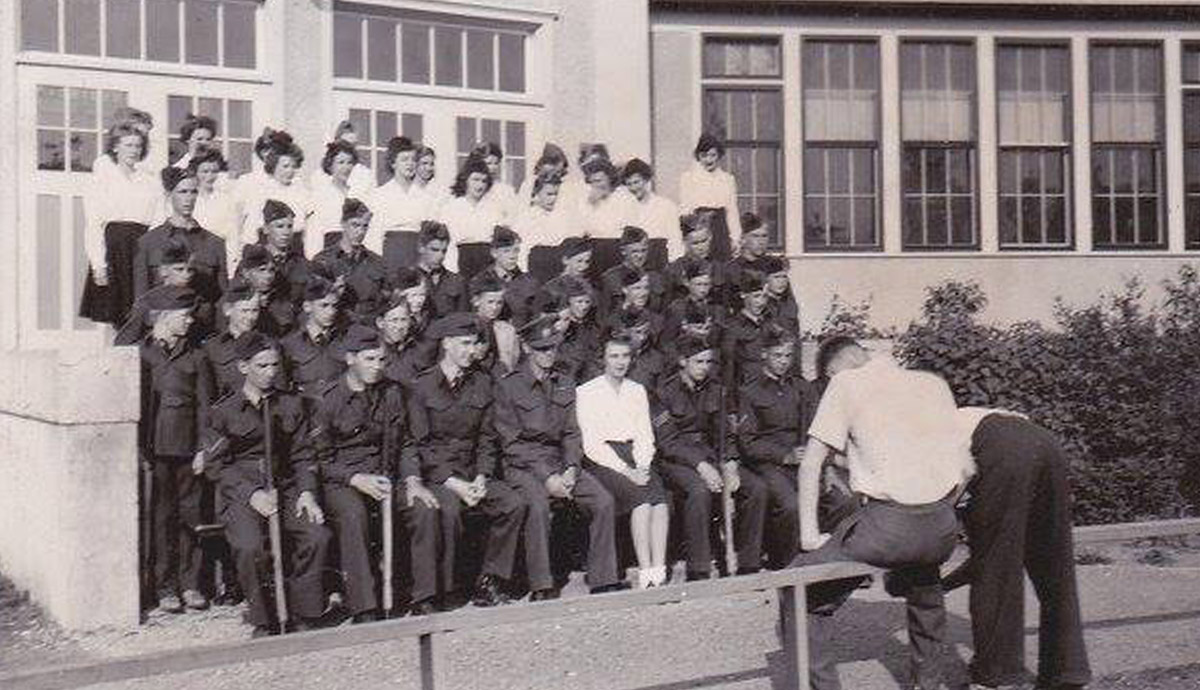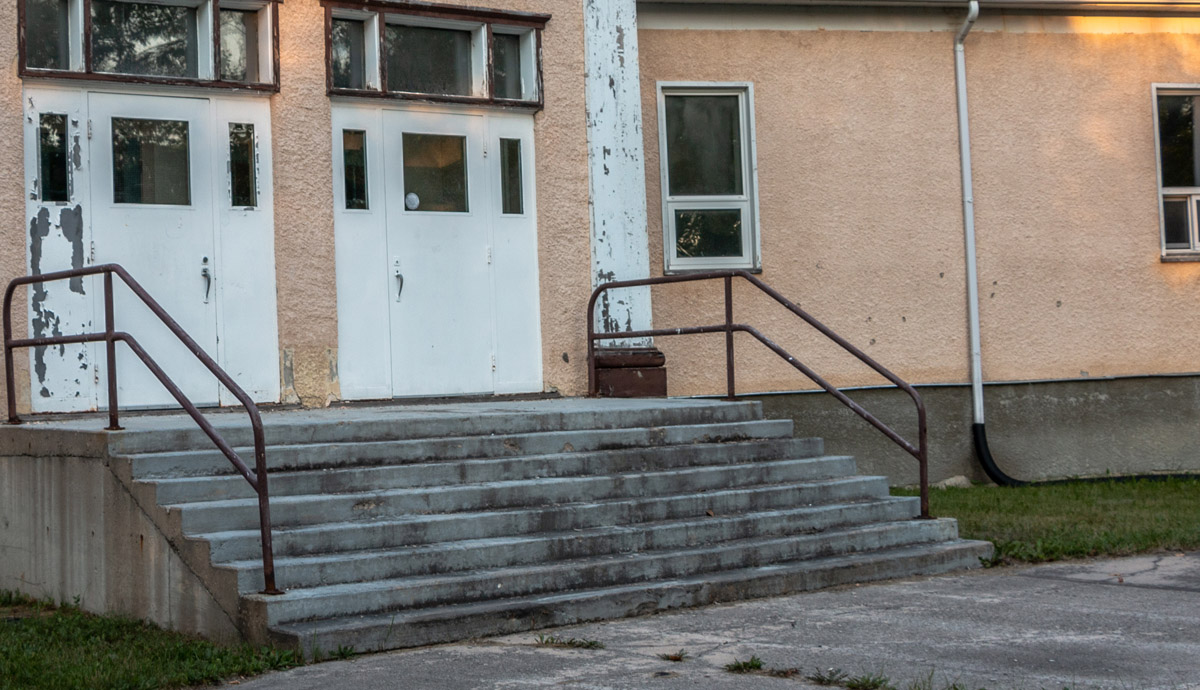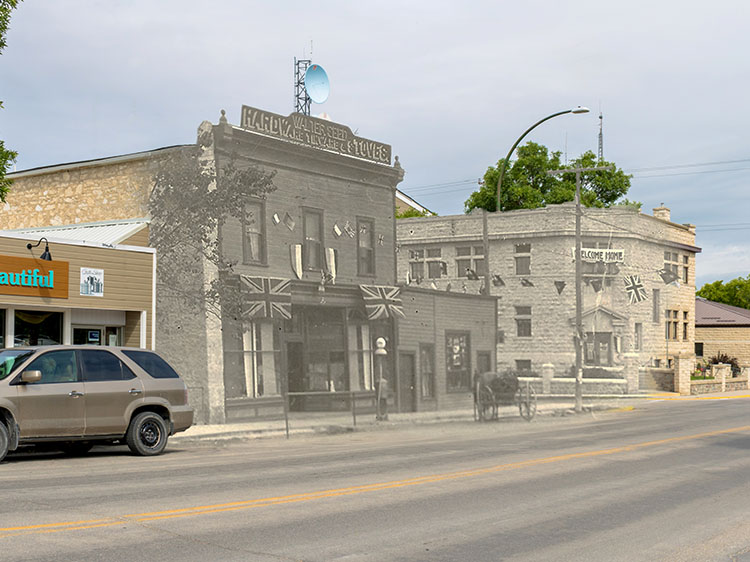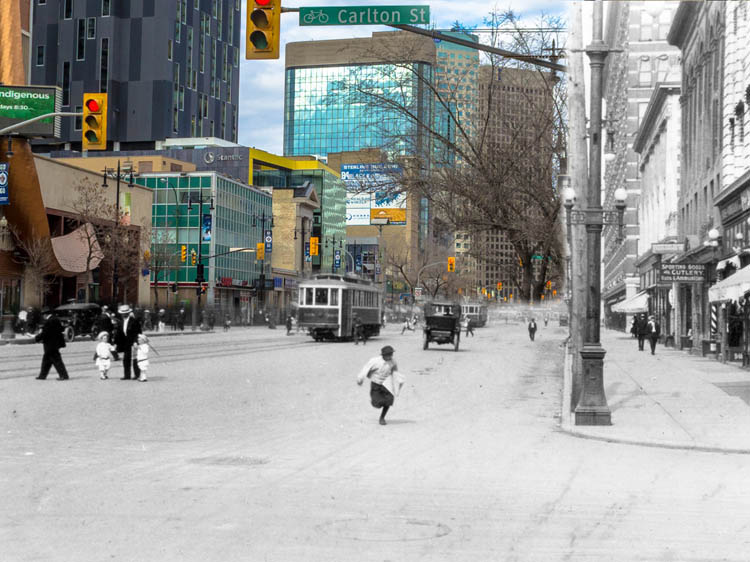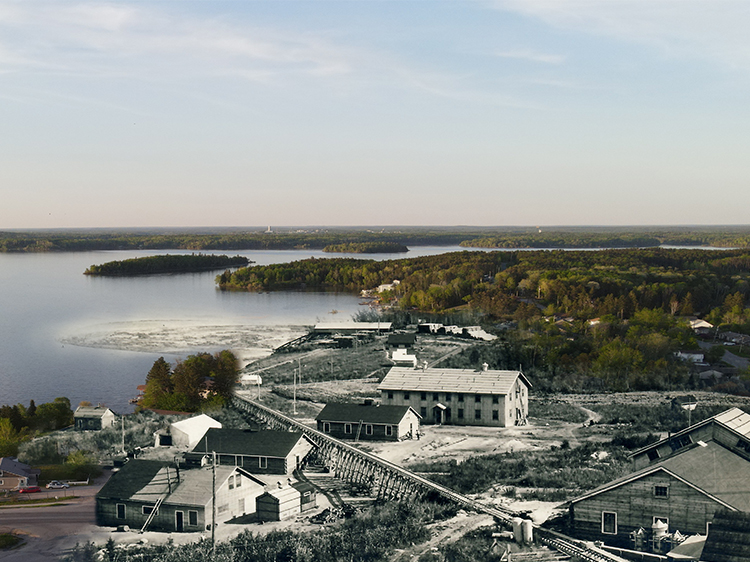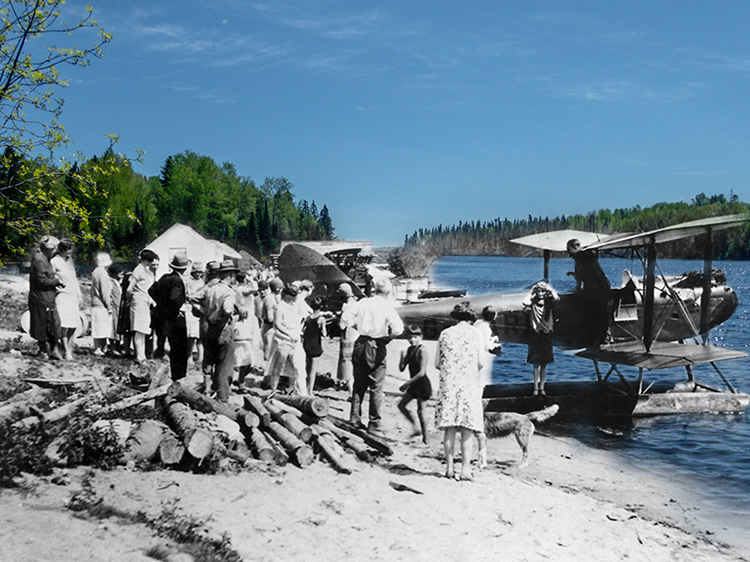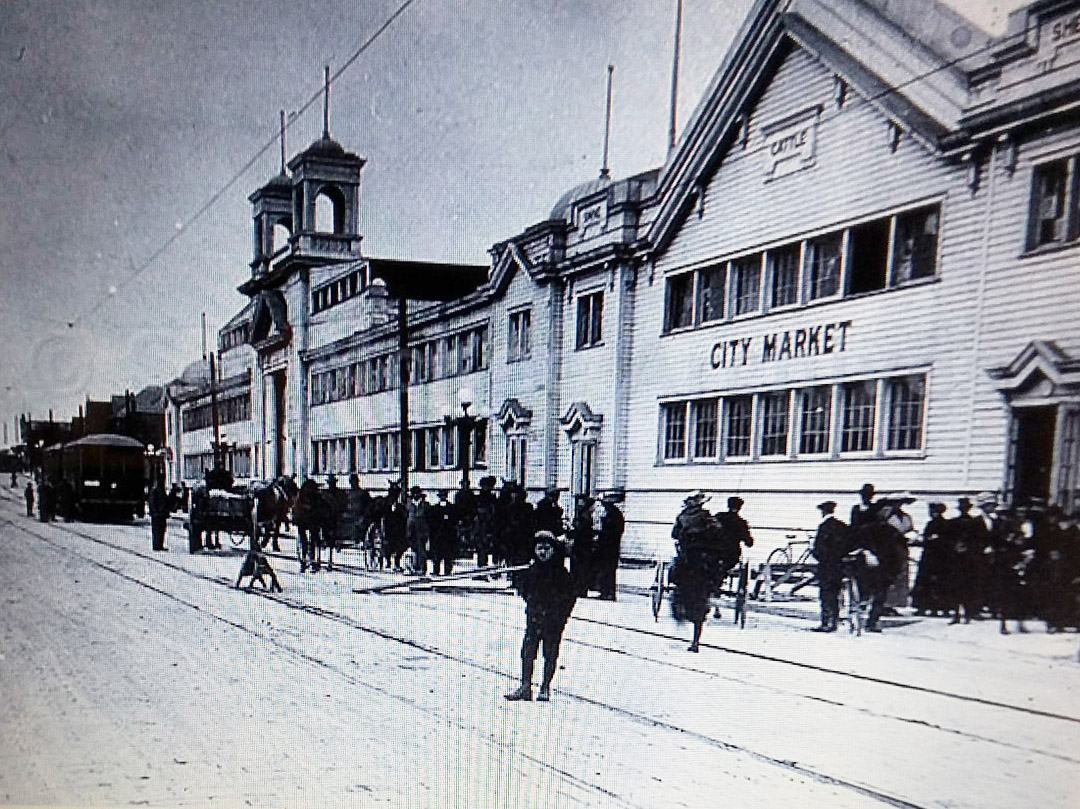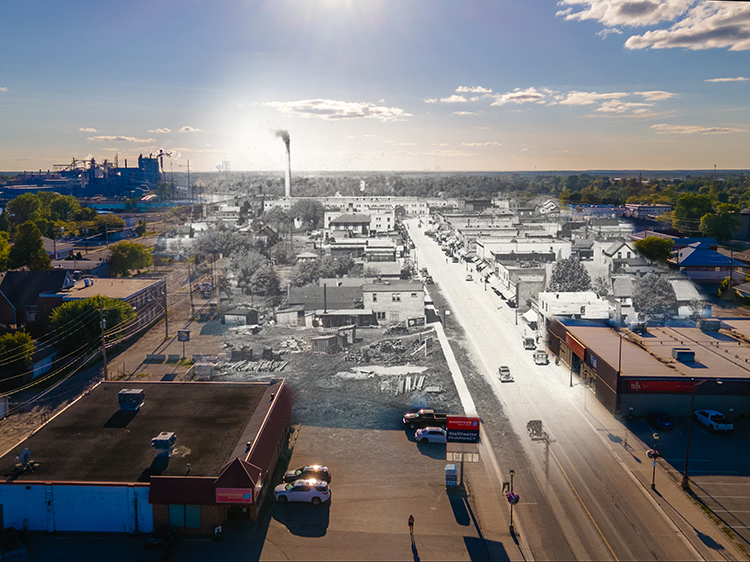Walking Tour
Garden in the Wilderness
The Story of Pine Falls
By Ian McKechnie
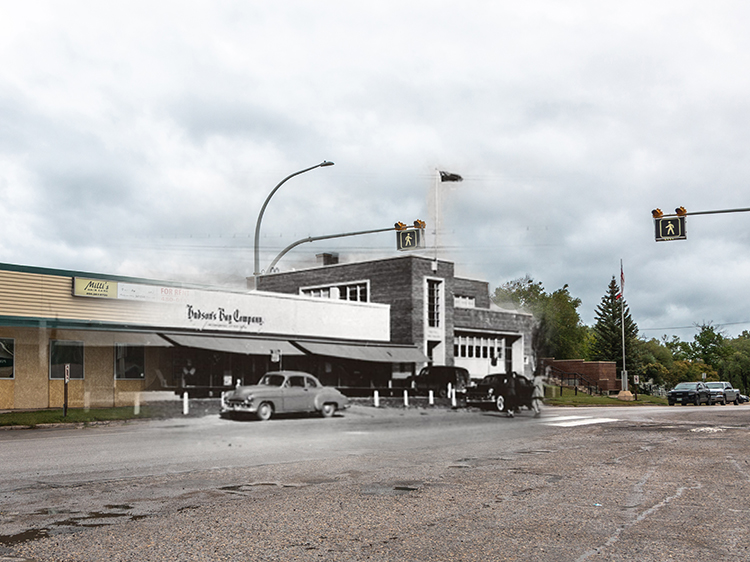
They called it the “Garden in the Wilderness.”
Pine Falls, literally carved out of the wilderness adjacent to the Winnipeg River some 120 kilometres northeast of Winnipeg, is one of the province’s most unique communities. Designed by famed town planner J.P. Mertz, the village had as its centrepiece a beautiful park-like space surrounded by dwellings that looked as though they were lifted directly from a town in Shakespeare’s England. A series of streets – all named for tree species – radiated out from this central gathering space.
It was an idyllic community, supported and sustained for over three quarters of a century by the Abitibi Power and Paper Company and its successor firms. Although the paper mill closed for good in 2009 and its massive complex on the northwest edge of town is no more, the amalgamated town of Powerview-Pine Falls remains home to over 1,200 people. It is well-known for outdoor recreation amenities, and tourists continue to flock to the community to go boating, fishing, and golfing.
Like other communities across Canada, Pine Falls’ landscape has changed and evolved over the years. Some once-familiar buildings have vanished from its streets; others have been heavily modified to accommodate new businesses and uses.
This walking tour takes visitors for a leisurely stroll through the shady streets of Pine Falls, past some of its most intriguing architectural jewels, and into the heart of a community that has always managed to reinvent itself despite the loss of its founding industry.
This project is a partnership with the Town of Powerview-Pine Falls and was funded by a grant from the New Horizons for Senior Program. We'd like to thank the residents of Powerview-Pine Falls for their stories and input, and we'd especially like to thank Heather Chevrefils, Assistant Chief Administrative Officer of Powerview-Pine Falls, who shepherded the project from inception to completion and made major contributions to the content.
1. The Fire Hall
ca. 1960s
There is something strikingly different about the Pine Falls fire hall. Unlike other Canadian towns, in which the fire hall might be a stately brick building constructed around the turn of the twentieth century, that in this community was emblematic of utilitarian pragmatism.
* * *
With limited resources and a large area to cover, collaboration between Pine Falls and neighbouring Powerview was key to providing adequate fire service. During the formative years of Powerview, the Pine Falls fire chief stated that his department would provide assistance to the former in the event of a conflagration. The Pine Falls pulp-and-paper mill even got into the act, offering Powerview use of its company fire engine, while the provincial Department of Forestry provided use of pumping equipment.2
Over the years, efforts were made to beautify the appearance of this corrugated-steel structure. Gardens, coniferous saplings, and hanging flower baskets enhanced the look of the Pine Falls fire hall, which would go on to serve as the local police headquarters and armoury. In later years, the building had an archery range in its basement.
In recent years this building has continued to serve as a public gathering place, and as recently as the spring of 2022 a ceremony was held here to bestow the honour of Freedom of the Town on the 38th Combat Engineer Regiment. Powerview-Pine Falls had been home to the 46th Field Squadron of the Royal Canadian Engineers at the end of the Second World War, which continues today as the 38th CER which is based in Winnipeg. Nevertheless, the 38th retains a tight-knit association with Powerview-Pine Falls, and the men and women of that unit attend Remembrance Day ceremonies here.
Today, the octogenarian Quonset hut remains in situ, a bench on the front lawn inviting passersby to sit and reflect on a time when community spirit and solidarity were symbolized by even the most utilitarian of public buildings.
2. Wings of Power
ca. 1950s
This building once served as Pine Falls' Catholic Church, and in this photo we see six young girls dressed for a special occasion standing on the front steps. Today this building is home to the Wings of Power Resource Centre.
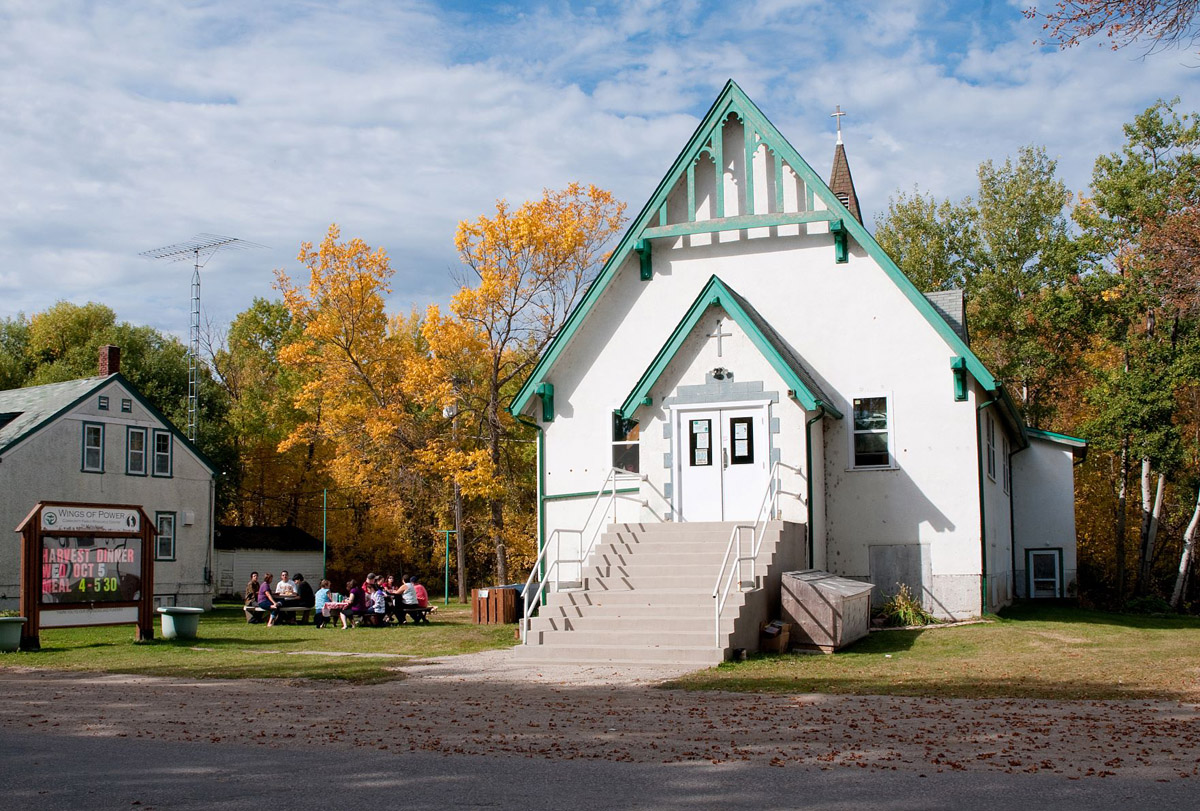
* * *
Dedicated in honour of St. Theresa, the new church was a simple, unadorned building with a steeply-pitched roof. In later years, this chapel-like church was deconsecrated and the building became home to Wings of Power, a resource centre.
3. The Post Office
ca. 1960s
Mail and parcel delivery in rural Manitoba was historically bound up in the story of the Hudson’s Bay Company. Throughout the nineteenth century, supplies were transported downriver from Lake Winnipeg to the area in and around Fort Alexander, which had both a HBC outpost and a post office. By 1910, dogsleds were being used to bring bags of mail into the area from Lac du Bonnet, which offered rail connection to points farther south.1
* * *
By the late 1940s, the shortcomings of the twenty year-old Pine Falls post office were becoming patently obvious. At only 200 square feet in size, it could not comfortably accommodate the great multitude of people awaiting service – whether millworkers waiting to send money to their families elsewhere or local residents gathering to pick up parcels at Christmastime. In a testament to the resourcefulness and ingenuity of Pine Falls residents, Myrtle Mackie secured permission from the Abitibi company to use an abandoned building nearby to handle overflow mail during the holiday season of 1948 and 1949. This “sub post office” sufficed until a new facility was completed.2
July of 1950 saw the federal government open a new post office in the community. Like many public buildings constructed in the years following the Second World War, the Pine Falls post office was imposing yet devoid of fanciful architectural elements. Clean rooflines, contrasting brick-and-concrete construction, and geometric shapes (notably rectangles) were the rule, which gave the building a vaguely Art Deco-like appearance and made it blend well with the plain-featured postwar properties elsewhere in town. About the only part of the Pine Falls post office to evoke an earlier era was the two-storey front entrance, which towered over the main doors, much like clock towers did in nineteenth century Canadian post offices.
The Pine Falls postal staff was thrilled with the new building, not least because of its much larger box capacity: at around 700 boxes, it promised to make the process of sorting, distributing, and sending mail to and from Pine Falls much more efficient.
In addition to serving as a post office, this stately structure also contains apartments in its upper level that afford tenants spectacular views of the surrounding townscape!
4. Pine Plaza
ca. 1930s
Today, the Pine Plaza is home to three businesses catering to the needs of Pine Falls residents. It is a long and low building; its design evocative of an old trading post. Nestled beneath the simple gables and eaves of the plaza are large display windows, which entice residents and visitors alike to come in and browse. These aren’t the first windows on this site to attract shoppers; for many years, the enormous windows of the Manitoba Paper Company’s Mercantile Store fulfilled the same function.
* * *
Like general stores elsewhere in the country, the Mercantile Store operated in part on a barter and trade system.2 Customers exchanged goods with the storekeeper in exchange for items or services of like value. Indigenous peoples from nearby Fort Alexander participated in this process, selling moccasins and other articles in the Mercantile over the course of its almost two decades in business. Also in keeping with the general store tradition was the home delivery service operated by the Mercantile. Under the watchful eyes of Johnny Karpenny, a wagon drawn by a team of horses made the rounds of Pine Falls, with crates of merchandise carefully piled into the back.3
Thanks to the dedication of staff like Maurice and Ruth Dansereau, Myrtle Lalor, George Sharpe, Nancy Taylor, and Ken Walton, the Mercantile Store thrived into the 1940s. It opened at 8:00 in the morning and closed up at 6:00 in the evening throughout the week, save for Saturdays, when the store remained open until 9:00 PM.
1946 saw the Hudson’s Bay Company take over the store, and a new facility was constructed across the street a few years later. Ever resourceful, subsequent owners of the Mercantile building did not tear it down. Through a mix of renovations and entrepreneurial spirit, the old store became home to a variety of businesses into the 1980s and beyond. While the look and feel of a Depression-era company store might be gone, the commercial vitality of this Tamarack Street address lives on.
5. Rupert's Landing
ca. 1950s
After the Hudson’s Bay Company took over operations at the Mercantile Store in 1946, a new building was constructed across the street and served as Pine Falls’ principal shopping centre for the next several decades. Today, this nondescript mid-century modern commercial space, known as Rupert’s Landing, is home to several tenants, including a grocery store, pharmacy, and optometrist.
* * *
1935 Average annual income: $313 A litre of milk: $ .10 cents A dozen eggs: $ .31 cents A can of tomatoes: $ .10 cents 1960 Average annual income: $1,672 A litre of milk: $ .24 cents A dozen eggs: $ .55 cents A can of tomatoes: $ .27 cents 1985 Average annual income: $15,903 A litre of milk: $ .98 cents A dozen eggs: $ 1.37 A can of tomatoes: $ 1.30 2008 Average annual income: $37,700 A litre of milk: $ 1.99 A dozen eggs: $ 2.57 A can of tomatoes: $ 1.30 2022 Average annual income: $49,600 A litre of milk: $ 1.95 A dozen eggs: $ 3.69 A can of tomatoes: $ 1.49
6. The Legion
ca. 1950s
Pine Falls came into being a decade after the end of the First World War, and for many of the first citizens memories of that horrific conflict were still fresh in their memories. A branch of the Royal Canadian Legion was established in Pine Falls on October 16 1928, but another two decades would pass before the Legion had a permanent home to call its own.
* * *
As with Legion branches across the country, that in Pine Falls served several purposes. It was first and foremost a benevolent organization, and has long contributed to the well-being of the community – notably, through the procurement of wheelchairs for the Pine Falls hospital.2 The Legion also played host to many social functions, not least an annual Christmas party for members and guests. Vimy Dinners and Armistice Dinners were much-anticipated events on local veterans’ calendars, and the Legion of course played a prominent role each year in decorating Pine Falls’ cenotaph – a simple stone cairn that was eventually replaced with a monument depicting the modern soldier.
Although the Royal Canadian Legion is synonymous with those who served in conflict zones around the world, its members have been supported by an enthusiastic and resourceful Legion Auxiliary. Formed on October 31 1929, the Auxiliary hit the ground running. Its thirteen charter members were especially active during the Second World War, when they furiously knitted woollen articles for those overseas. Annie Patterson was known for adding an extra special touch in the form of her name and address slipped into the socks destined for war-torn Europe.3
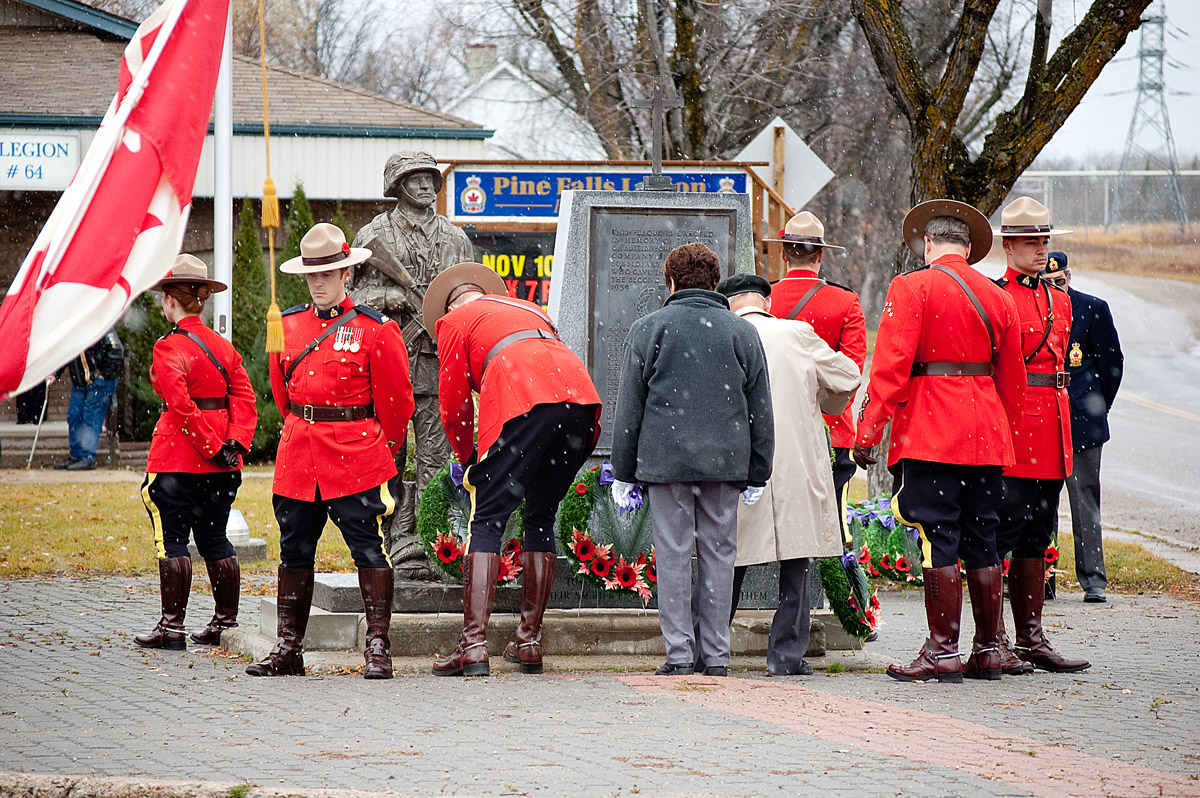
Over 40 citizens of Pine Falls, many of them employees of the Abitibi Paper Co., made the supreme sacrifice and never returned to their homes and livelihoods. “Their names liveth forevermore” in this garden in the wilderness.
7. The Locomotive
ca. 1930s
Surrounded by a chain-link fence between MB-11 and Maple Street is a restored steam locomotive once operated by the Abitibi Paper Company. It was the last steam locomotive to operate daily in Western Canada. Though elegant in its black finish, it looks strangely out of place in this location opposite the Manitou Lodge. Long gone are the ties and rails which linked Pine Falls to the rest of Canada, and the shrill blasts of locomotive horns and whistles haven’t reverberated through the village in years.
* * *
Train service to and from Winnipeg was provided only three times a week, and while the station grounds did not influence the development of the townsite, the station itself was fairly large and reflected the important role railways played in remote communities across much of western Canada.2 Tudor Revival in design, the station sported half-timbering in the gables at trackside and at the westernmost end of the building. A picket fence surrounded the structure and enclosed a small garden on the south side, while railway yards north of the station held rows of freight cars filled with paper and other products bound for points farther south.3
Throughout the 1940s and 1950s the arrival and departure of passenger trains generated much excitement, and the station platform bustled with activity as local residents greeted relatives or bid adieu to loved ones. Station agents included a Mr. Foster and Ray Bowman, while J.J. Jackson served as section foreman.4
By the mid-to-late 1950s, the Canadian National Railway had largely converted its locomotives to diesel operation. Many industries, however, retained steam locomotives for use in and around their facilities. The Abitibi Paper Company was no exception. No. 30 was built by the Montreal Locomotive Works in 1922 and was originally destined for a railway in China. When this arrangement failed to materialize, the locomotive was acquired by the Abitibi Railway & Navigation Company of northern Ontario before falling under the ownership of the Manitoba Paper Company in 1955. No. 30 was retired from service in 1963, and was the last steam locomotive in western Canada to operate in regular service.5
The Pine Falls subdivision was acquired by the Central Manitoba Railway in 1999, and railway service remained a vital part of Pine Falls’ economy as long as the paper mill was in operation.6 Ten years later, the mill shut down for good and was dismantled not long thereafter. Spur tracks were taken up, and a lone diesel switching engine used by Canadian National was left isolated in the middle of an overgrown lot once home to Pine Falls’ economic lifeline.7
8. Manitou Lodge
Powerview-Pine Falls Facebook Group
ca. 1950s
Though Pine Falls was primarily an industrial town, its location on the Winnipeg River made it an attractive place to spend a vacation. Individuals who had business to attend to in town – whether at the paper mill or another enterprise – needed a place to stay. For almost three quarters of a century, Manitou Lodge on Highway 11 has been a symbol of Pine Falls’ hospitality.
The lodge was built in 1948 and was operated by the Manitoba Paper Company under the management of Gordon Mulligan (1909-1978). Mr. Mulligan had arrived in Pine Falls four years prior, in 1944, to manage the staff housing for the paper mill. After Manitou Lodge was completed Mr. Mulligan and his wife moved into the hotel, which they managed for another twenty-one years.1
* * *
Apart from the regular fare of summer guests looking to “get away from it all,” Manitou Lodge regularly welcomed visitors who were in town for special events or conferences.
Golf tournaments such as those organized by the C.N.R. Ladies Golf Club often wrapped up with dinner at Manitou Lodge;4 while in 1966 participants in a week-long management course offered by the University of Manitoba could enjoy the hotel’s food and accommodation for $200.5 Hotels have historically been used in Canada as places to recruit military personnel, and Manitou Lodge was no exception, hosting the Royal Canadian Navy recruitment unit in September of 1956 and 1957.6 Also numbering among the guests at Manitou Lodge were prominent provincial politicians. In January 1961, Manitoba Premier Duff Roblin and his eight-person cabinet retreated to the hotel to prepare policies ahead of the next session of the legislature. As the Winnipeg Evening Tribune noted with an air of intrigue, “the lodge at Pine Falls – 95 miles northeast of Winnipeg – which became the seat of Manitoba’s government for two days, is secluded by spruce and birch trees.”7
The hotel provided employment for many local residents. A beverage room waiter working at Manitou Lodge in 1970 made between $330 and $390 a month for dispensing drinks,8 though this service later faced competition from a new liquor store on Pine Street.9
While Manitou Lodge’s imposing facade no longer welcomes guests who choose to “spend a few days” in Pine Falls, it continues to house apartments as well as the town’s fitness centre.
9. The Chateau
1941
While the life of company towns such as Pine Falls revolved around the host industry, efforts were made to ensure that the monotony of work was balanced out with recreational opportunities. Such was the rationale behind the construction of The Chateau, at 4 Maple Street.
Built in 1937 by J.W. Johannson – who lived in the adjacent house at 2 Maple, and was known to walk around in a housecoat – the Chateau was no doubt named for its imposing appearance. With their steeply-pitched roofs and Tudor Revival architecture, 2 and 4 Maple stood in sharp contrast to the utilitarian design of Pine Falls’ industrial structures.1
* * *
When residents weren’t taking in the latest in movies and newsreels, they were competing at the Chateau’s popular bowling lanes. The building had offered bowling facilities since it opened, and the much-anticipated games always attracted comment in the press. “A perfect game and then a 1,000 series in five-pin play during the same week. How great that is!” exclaimed Harold Loster in the Winnipeg Tribune on March 27 1974. “It was in Pine Falls where the perfect game was recorded. The Chateau Lanes was the bowling house and it’s the first one in the 37 years that they have been bowling out there,” Loster wrote.3
Apart from bowling and cinema, the Chateau often played host to many special events. The University of Manitoba’s Dr. H.C. Grant gave a lecture to a community gathering at the Chateau on April 6 1941, with the local Legion band providing musical entertainment.4 Starting in 1947, graduating students from Pine Falls Collegiate received their diplomas at ceremonies held in the Chateau,5 while the Pine Falls Horticultural Society held its first garden show there on August 22 of that year.6 Various organizations met at the Chateau, notably the Pine Falls’ Business and Professional Women’s Club, which installed its inaugural slate of officers there in 1961.
For many of Pine Falls residents, though, the Chateau is best remembered as a wedding venue. Its dance hall hosted many a reception for newlyweds and those celebrating milestone anniversaries,7 while its beautifully-landscaped grounds made it a popular place to take pictures.8
In more recent times, the Chateau building has operated as a video rental business – evoking memories of when local residents took in the movies beneath its cavernous roof.
10. Elm and Tamarac
ca. 1930s
Allow your eyes to gaze west upon reaching the intersection of Elm and Tamarac Streets, and just past Sonny’s Chicken House you will see what is surely one of the town’s largest and most beloved of public facilities: the combined curling rink and hockey arena. Known today as the Access Arena after its principal sponsor, it carries on a long tradition of sports and recreation in Pine Falls.
The first purpose-built rinks for curling, hockey, and skating were built in the late 1920s, and were situated near a former dining hall used during the construction of the town site. By the time Christmas of 1945 rolled around, the people of Pine Falls were making good use of a new outdoor rink on the site of the present facility. Still, something larger and more permanent was desired.1
* * *
The new recreation centre – designed by Manitoba Paper engineers Myron Turner, D. Munro, and C. Rempel – was staggering in size. Members of the Paper Kings hockey team and those skating for the sheer enjoyment of it were thrilled to have use of a rink measuring 80 feet in width by 180 feet in length. Their counterparts in the curling community played their game on four sheets of ice measuring a combined 80 feet wide by 140 feet long. Towering between the two rinks was a two-storey space that housed a snack bar, dressing rooms, and enough room for dances and indoor badminton, tennis, and volleyball games.3
One had to look hard to find a citizen of Pine Falls who was not involved with the arena project in one way or another. “Folks at Pine Falls are so eager to get the centre completed they are still holding onto daylight saving time,” the Winnipeg Tribune’s Dave Adams wrote admiringly on October 5 1949.4 The new arena was officially opened on February 8 1950, marking the completion of an $80,000 facility into which had been put 7,000 hours of labour by some 300 volunteers.
For the next sixteen years, this building saw many memorable curling bonspiels, hockey matches, and figure skating events transpire within its walls. When it was lost to fire in 1966, the ever-resourceful citizens of Pine Falls poured money and time into making sure their recreational centre rose phoenix-like from the ashes. What you see today is a testament to a community’s resolve and resilience.5
11. Poplar and Cedar
Powerview-Pine Falls Facebook Group
1928
For the first several years of Pine Falls’ existence, employees of the pulp and paper mill were accommodated in a pair of two-storey buildings on Poplar Street not far from Cedar Street. Sporting gambrel roofs and two-storey porches, these imposing buildings were eventually dismantled when more permanent residences appeared during the 1930s.
* * *
In 1957, the Paper Kings had the distinction of being named the Intermediate AA Western Canada Champions – and were honoured in 2009, when the 1956/1957 team was named to the Manitoba Hockey Hall of Fame. Today, members of the Paper Kings still play for recreational purposes and are supporters of minor hockey in Pine Falls. They continue to be active in the community, hosting socials, a baseball tournament, and a beer garden during the town’s annual 4P Festival.2
A sporting community to its core, modern-day Pine Falls can claim two well-known sportsmen as its own: Bill Watson (b. 1964), who went on to play professionally for the Chicago Blackhawks from 1985 through 1989, and boxing champion Larry “Razor” Sharpe (b. 1974).3 4
12. Cherry and Birch
1927
One of the earliest recorded musical events in Pine Falls transpired in the late 1920s. To celebrate the completion of the village’s new recreational hall, a band consisting of pianist Jack Nixon; cornetist Fred Luhde; violinist Rupe Rigg; trumpeter Fred Bleakney; and violinists Jim McNair and Larry Snarely serenaded crowds into the night. A few years later, this band organized a dance to farewell local residents who had to pull up stakes in Pine Falls and look elsewhere for employment. According to the recollections of Laurence Frayne, even the 25 cent admission fee proved to be too much and only one person showed up – despite the band waiting until close to midnight.1
* * *
Over the years, Pine Falls’ residents have enjoyed concerts at which local bands have taken centre stage. These have included the Pine Falls Girls’ Drum & Bugle Band, established in 1955; the Pine Falls Pipe Band, which was formed in 1968; and a local orchestra specializing in popular music. Known as the Stardusters, this group was formed not long after the Second World War and entertained audiences for another couple of decades. Perhaps one of the most memorable occasions in the annals of Pine Falls’ music scene, though, happened in 1939, when the town’s brass band performed in Winnipeg for King George VI and Queen Elizabeth, during their royal tour of Canada.3
13. The Village Green
ca. 1970s
Reaching the corner of Balsam and Holly Streets, one will come face to face with the village green – and in particular, a sign indicating that this space hosts a playground and other amenities for joggers, walkers, and anyone wanting to enjoy the great outdoors. That the planners of Pine Falls made this parkland so central to their plan speaks volumes to the importance they placed on physical fitness.
In this aerial photo of Pine Falls you can clearly see the Village Green at the bottom right at the centre of the planned community.
* * *
Named in honour of longtime Pine Falls baseball player Leonard Rupert (ca. 1924-1985), the village’s baseball diamond is located south of Highway 11 between Pine Falls and Powerview. It opened for use in 1985 and replaced an earlier field where games of softball had been played since 1929.1 In May of that year, a baseball league was formed and the opening game played between the “Nationals” under Buck Hay and the “Cougars,” under the leadership of George Martin. The game was won 11-10 by the “Nationals,” and would launch a long tradition of baseball in the village – a tradition that has included not only teams for adults but also little league players, as well.2
Not far away from the Leonard Rupert Memorial Park is the Pine Falls Golf Club. One of the province’s best-known golf courses, it traces its history back to the formative days of the village in 1927, and has played host to several memorable golf tournaments over the years.3 On August 22 1943, the Scottish-born Manitoba golfer Alex “Sandy” Weir (1892-1968),4 who had been playing professionally since the 1910s, scored a one-over-par 73 in a field of almost 150 contestants in the Northeastern Manitoba Open held at Pine Falls. “Amiable Sandy had planned to play his golf at Winnipeg Beach during the weekend, [but] changed his mind at the last minute to make the journey to Pine Falls,” wrote Herb Manning in the Winnipeg Evening Tribune.5 Apart from prominent golfers like Weir, the Pine Falls golf links also welcomed members of the C.N.R. Ladies Golf Club and locals wanting to spend a day on the fairways.6
Back in Pine Falls proper, tennis players could take advantage of the courts on the village green. They saw their first match in May of 1929, when mill manager C.C. Irvine played a game against town planner Joe Mertz.7 Those original courts have since been replaced, and tennis continues to be popular.
14. Church of the Advent
Powerview-Pine Falls Facebook Group
ca. 1950s
Pine Falls’ Anglican church was formally dedicated on the first Sunday of Advent in 1937 and was aptly consecrated as the Church of the Advent. The second Protestant church in the village, it bore more than a striking resemblance to the United Church that had been built eight years before.
* * *
The first Anglican minister to serve the people of Pine Falls was the Rev’d. Canon C.H. Fryer, who concurrently served the congregation of Christ Church in nearby Fort Alexander. Services took place for the first several years in the Pine Falls School. While Fryer died before the Pine Falls church could be completed, he was memorialized in both the church’s altar and in two pews gracing the front of the church.2 Fryer’s tireless efforts to build a church for the people of Pine Falls were no doubt appreciated by those gathered in the village for the twenty-fifth session of the Synod of the Diocese of Keewatin, which was hosted by the Church of the Advent in 1955.3
Over time, Pine Falls’ Anglican population drifted away and the Church of the Advent was grouped under the Pine Falls Pastoral District in 1971. This encompassed Anglican churches in Great Falls, Lac du Bonnet, Pinawa, Pointe du Bois, Rennie, and Whitemouth.4 Today, the Church of the Advent remains one of the community’s architectural gems – a pastoral oasis amid a changing landscape.
15. Sunnywood Hospital
Powerview-Pine Falls Facebook Group
1930
Today, the residents enjoy access to modern healthcare facilities in the form of the Pine Falls Health Complex on Maple Street. Around the corner is the main entrance to the Sunnywood Manor long term care home. Built in 1985, it is situated on the site of the town’s old hospital. That facility in turn dated back to the late 1920s, when the town was still in its infancy.
* * *
Dr. Bissett was succeeded in 1950 by Dr. K.I. Johnson, and in 1951 the ever-resourceful women of Pine Falls formed the Hospital Auxiliary to support their local healthcare facility. The following year saw them busily engaged in furnishing a new wing with new draperies, gowns, and linens. Later on, the Auxiliary dedicated their energies towards fundraising, with the proceeds from many a tea, bake sale, and auction going towards purchases of new equipment for use in the hospital.2
By 1964, the Pine Falls hospital had merged with a nearby hospital operated by what was then called the Department of Indian Affairs. The latter building was demolished, while the number of beds in Pine Falls increased to 48.
Today, the professionals employed at the Pine Falls Health Complex carry on the tradition of care practised close to a century ago by those early Pine Falls physicians and nurses. Between 2010 and 2020 a number of additions and improvements were made to the facility, including a helipad for the STARS air ambulance service; an EMS building; and the Giigewigamig Traditional Healing Centre.
16. Village Green Amenities
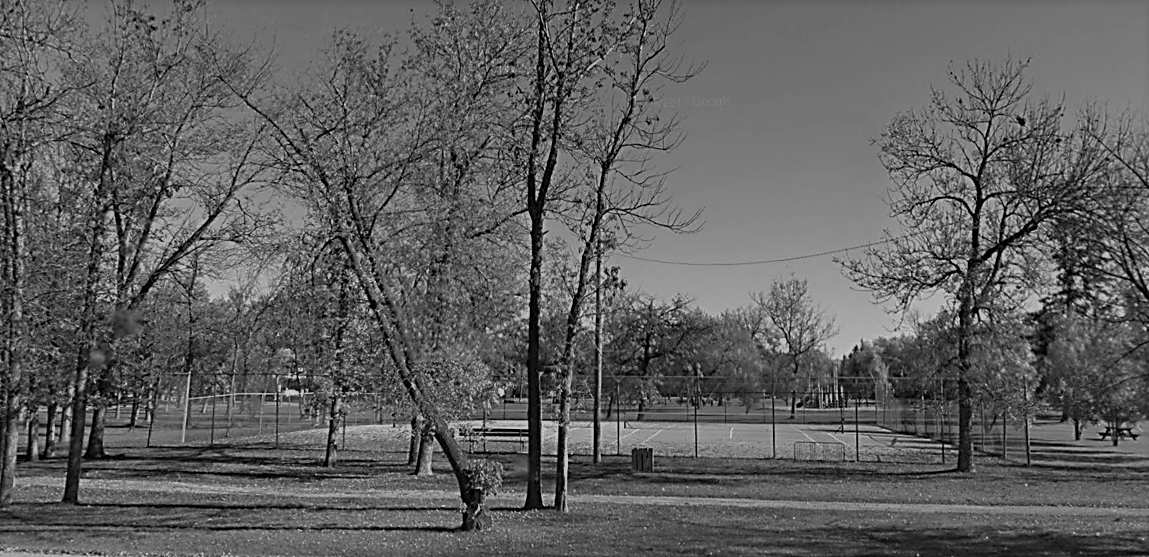
ca. 1980s
The Village Green, located in the heart of Pine Falls, is a lovely green space that houses a fun playground, an outdoor exercise zone and a multi-use court suitable for tennis, pickleball, and basketball. Upgrades have made the quarter mile-long path surrounding the space a safe, barrier free walkway that provides easy access for the entire neighbourhood, including Sunnywood Manor and the Pine Falls Health Complex.
* * *

Through an age-friendly initiative, the same group of ladies were able to incorporate exercise equipment near the playground to allow people of all ages to get out and enjoy the Village Green. This exercise equipment includes a bicycle, a chest press, a rower, an elliptical and a stair climber!
The most recent upgrade was to the original tennis court. What once was 2 tennis courts, is now a tennis court, a pickleball court and a basketball court, complete with bleacher seating, so family and friends can watch the activities and friendly tournaments.
17. Beautiful Homes on Balsam
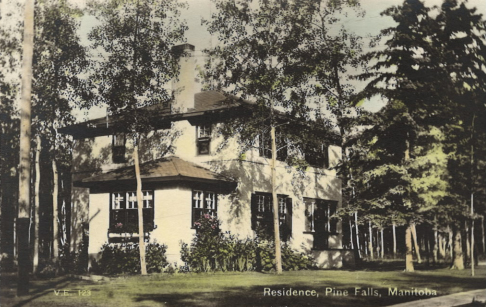
Those strolling through the village green towards Balsam Street might be forgiven if they think they have walked into Elizabethan-era England. Rising before them at 5 Balsam is a large dwelling sporting a pair of gables and enough half-timbering detail to whet the appetite of any Anglophile. Like many buildings in Pine Falls, Tudor Revival architecture is the norm – a deliberate decision on the part of town planner J.P. Mertz, who, working with Montreal’s Leonard Schlemm, wanted to “adopt the English type of cottage to local conditions and group the various types in pleasing perspective.”1
* * *
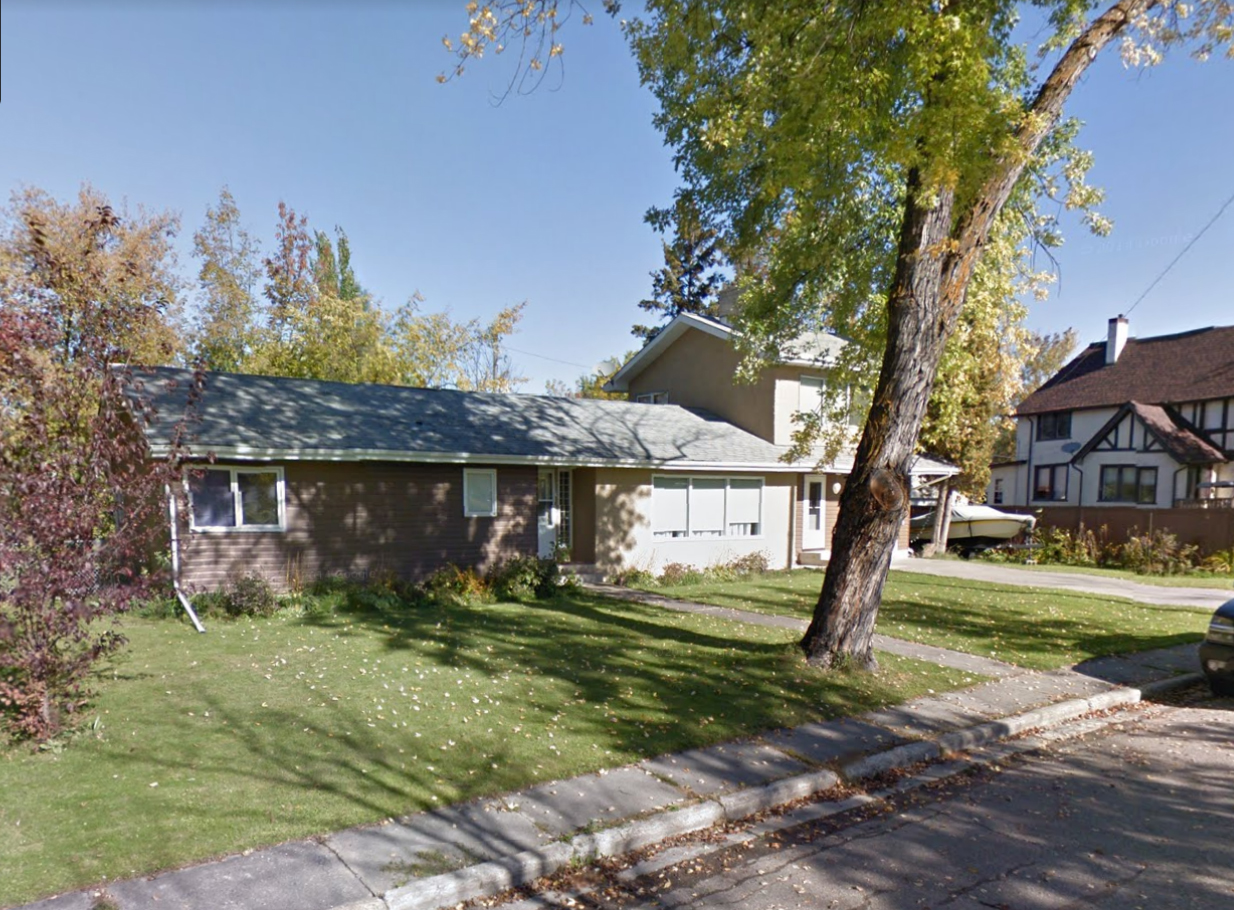
For Pine Falls’ town planners, grouping Tudor Revival residential architecture in “pleasing perspective” meant arranging for the largest examples to overlook the expansive village green – or at least in close proximity to it. After all, this was to be the town’s focal point; something evocative of similar spaces in “England’s green and pleasant land,”2 which Mertz and his colleagues attempted to emulate in their designs. English influences could also be found elsewhere in the neighbourhood, with the narrow streets winding their way through Pine Falls being patterned after those in British villages.3
Although one might expect a company town in the Canadian wilderness to be a paragon of economic equality, with comparatively modest housing grouped together in close proximity, subtle class distinctions were as noticeable in Pine Falls as they were in larger cities. This was especially evident on Balsam Street. Unskilled workers could acquire a dwelling for $2,500, while those with more experience could have something slightly more upscale at $5,500. The largest and most elegant of Pine Falls’ residential buildings, on the other hand, were reserved for company superintendents.4 Many of these were built on Balsam, and were anchored by the palatial mill manager’s house at the intersection of Balsam, Hemlock, and Spruce Streets. Dr. E.D.R. Bissett, the company’s house physician, built a splendid-looking residence at 1 Balsam, complete with a spacious front lawn.
While distinctions in the Manitoba Paper Company’s employment hierarchy are reflected in the design and placement of Balsam Street’s houses, there can be no question that the company was a benevolent and resourceful one. Workers living elsewhere in the village had access to lawn maintenance equipment and other amenities they could use in keeping their properties as beautiful and inviting as the village green you have just crossed.5
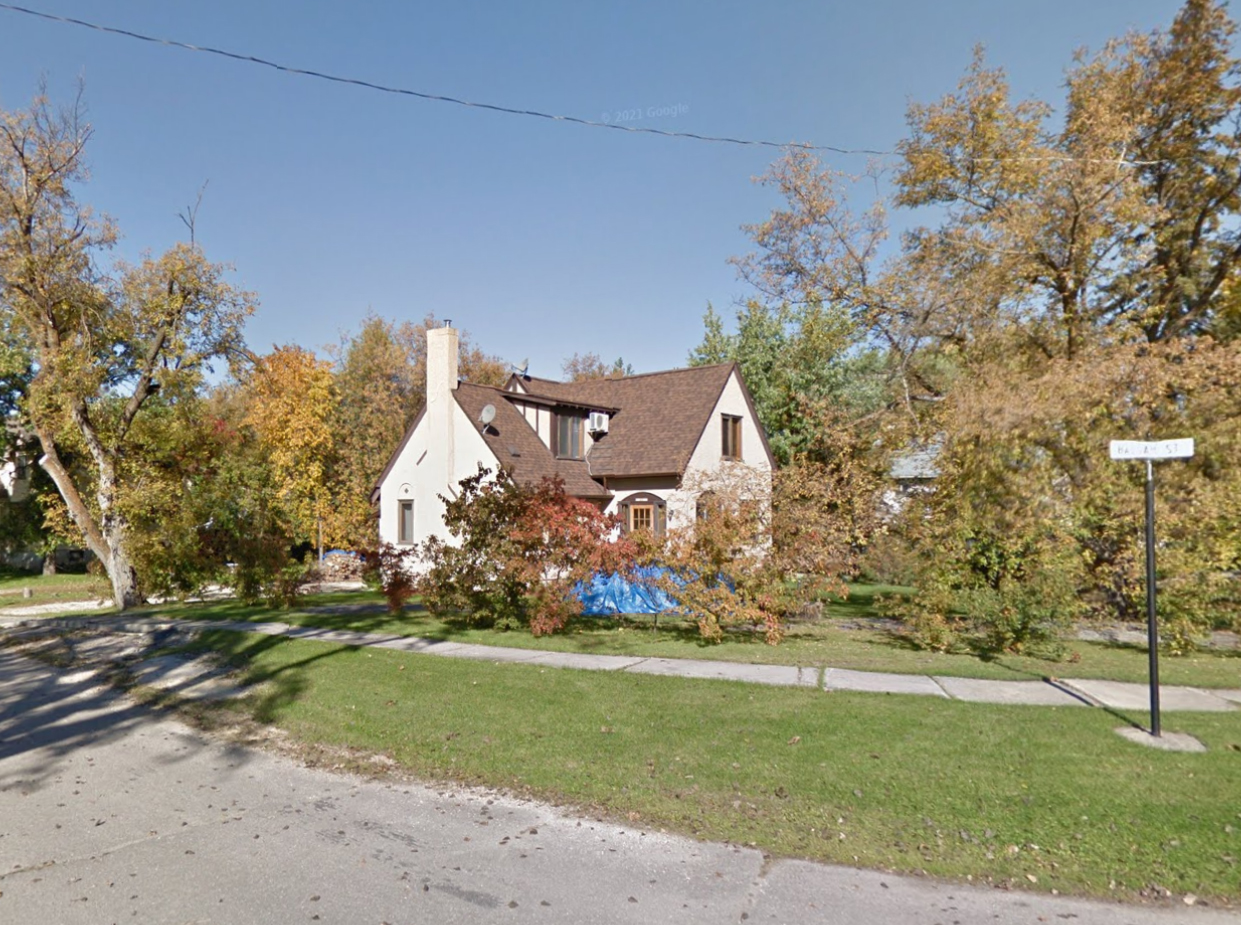
18. 5 Balsam Street
ca. 1930s
Complete with double gables and extensive half-timbering, 5 Balsam Street evokes the Tudor Revival atmosphere sought by the town’s planners when they laid out this garden in the wilderness close to a century ago.
19. 7 Balsam Street
1926
Though not a Tudor Revival design, 7 Balsam Street’s massing, hip roof, and large yard all contribute to its identity as one of Pine Falls’ grander properties.
20. 9 Balsam Street
1926
With its hip roof and steep gables, 9 Balsam Street is an amalgam of both Tudor Revival and Arts-and-Crafts architecture. Both styles could be found elsewhere in Pine Falls, evoking both British influences and current trends in North American domestic architecture.
21. The Mill Manager’s House
ca. 1930
Towering behind the trees and hedges at 7 Walnut Street is the steeply-pitched roof of a stately craftsman-style structure known locally as the Mill Manager’s House. Like many of the other residential properties encircling the village green, its size reflects the important role and influence management of the Manitoba Paper Company had in the life of Pine Falls.
* * *
Mr. Irvine was known for his meticulous attention to detail, not least when it came to property maintenance. Employees who let their gardens and lawns become infested with weeds were sure to hear about it from the mill manager himself!2 Irvine was an enthusiastic sportsman, and faced off against town planner Joe Mertz on the village tennis courts when they opened in the spring of 1929. Irvine’s sporting interests extended beyond tennis and he was reported to have been a commanding presence on the baseball diamond, curling rink, and golf course.3
Mill managers wielded considerable influence in Pine Falls. Apart from running the paper mill and being involved in the community’s social and recreational life, they also functioned as a de facto mayor: former Pine Falls police chief Harry Rowe recalled that he answered only to the Mill manager.4 It was no coincidence, then, that his official residence on Walnut Street resembled in both form and function a large manor house.
Though mill managers no longer overlook the village green, their regal-looking residence remains – an imposing reminder of their benevolence and leadership they played in the community. Though many mill managers have passed through 7 Walnut over the last century, Charles C. Irvine’s legacy has literally left its mark on the property: a gazebo on the grounds still bears the initials his daughter carved into it many years ago.
22. Pine Falls United Church
1946
Pine Falls United Church is a modern structure by church architecture standards. Devoid of decorative details – save for a large cross over the main vestibule and a stylized cross forming a window on the south facade – it is more than half a century old. Built in 1975 to replace a church dating to 1928, Pine Falls United Church continues to be a focal point for the community.
* * *
Thanks to the generous and resourceful people comprising the 50-strong congregation, a new church was built in 1928. In common with almost all of the other public and residential buildings throughout Pine Falls, the church was distinguished by Tudor Revival architecture, with half-timber work gracing both the narthex and the transepts. The church was formally dedicated on October 14 1928, and gracing the pulpit on that occasion was the Rev’d. Charles W. Gordon – a nationally-known preacher best remembered for the novels he wrote under the pen name Ralph Connor. Gordon’s son, John King Gordon (1900-1989) also entered the ministry and served the burgeoning Pine Falls congregation from 1926 through 1929. (Only in his twenties at the time, the younger Gordon would go on to serve the United Church of Canada in various capacities through the 1930s, to work with the United Nations through the 1950s, and to be awarded the Order of Canada in 1977.)2
Music had an important place at Pine Falls United Church from the outset. A small pipe organ was eventually installed at the front of the church before being replaced with an electronic organ in 1952.
Among the parishioners who took in the music offered by the Pine Falls United Church choir at services was Charles C. Irvine (1881-1945), who served as Manager of the Manitoba Paper Company for the first twenty years of Pine Falls’ existence. Irvine was one of many citizens for whom the United Church was not merely a place to go on Sunday morning, but also a community hub throughout the remainder of the week. The United Church Women held many a bazaar and tea in Pine Falls church hall over the years, and their home baking was always much-anticipated at Christmastime. By the 1980s, a Day Care Centre was operating out of the church basement – reinforcing the community-minded mission Pine Falls United Church has maintained for close to one hundred years.3
23. Pine Falls School
Powerview-Pine Falls Facebook Group
1944
Like virtually every other service in the community, the now-closed Pine Falls School was owned and operated by the Manitoba Paper Company and served the educational needs of children from not only Pine Falls but also nearby Fort Alexander, Powerview, and St. George’s.
Sadly, this beautiful historic building was destroyed in a fire on October 14, 2023.
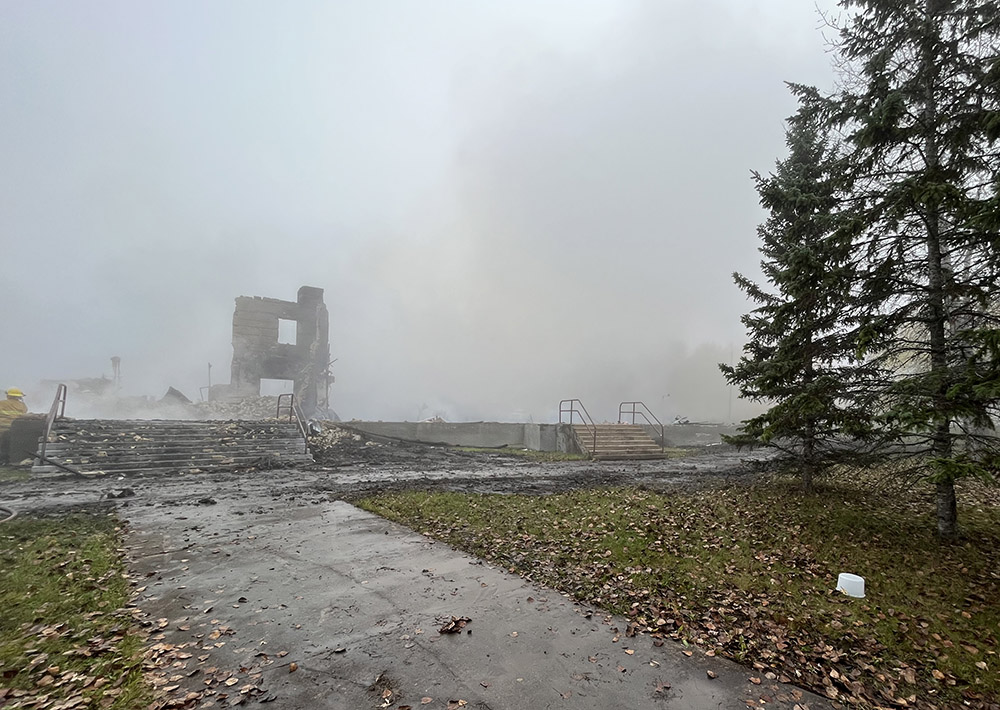
* * *
Despite its imposing size, the Pine Falls school lacked a conventional gymnasium until one was finally added in 1965. Basketball tournaments, concerts, gymnastics and other extracurricular activities transpired in a large hall on the opposite side of town, near the railway tracks. This space was well-used, for when Pine Falls students were not busy at their desks, they were competing among themselves and against students from schools in other communities in a variety of athletic contests – not least at the Pine Falls Annual Field Day, which took place for the first time in 1927.2
Many remarkable educators passed through the corridors of Pine Falls School over the course of its 81-year existence. Some went on to serve Manitoba’s education sector in other capacities, notably Howard M. Dunfield (1912-2000), who served as principal in Pine Falls from 1943 through 1952. Dunfield would eventually become Chief School Inspector for the Manitoba Department of Education and retired in 1977 after serving as the province’s Associate Deputy Minister of Education.3
By 1963, there were some 260 students enrolled at the Pine Falls School in grades 1 through 8. While elementary school enrolment remained high through the ensuing decades, high school students eventually began attending classes at neighbouring Powerview Collegiate as well as in other communities, and occasionally the numbers of graduates was as low as four.
Pine Falls School remained in operation until closing for good in 2007.
24. The Swimming Pool

ca. 1980s
As with other recreational amenities in Pine Falls, the community swimming pool has changed locations over the years. From its origins in the Winnipeg River to the vast outdoor facility enjoyed by residents today, it has been a fixture of summer life for close to a century.
* * *
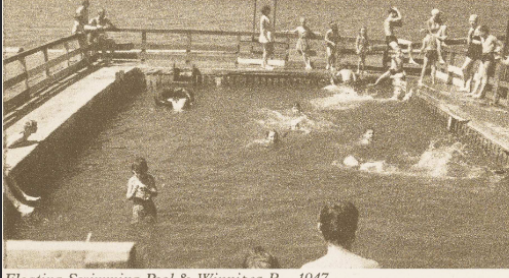
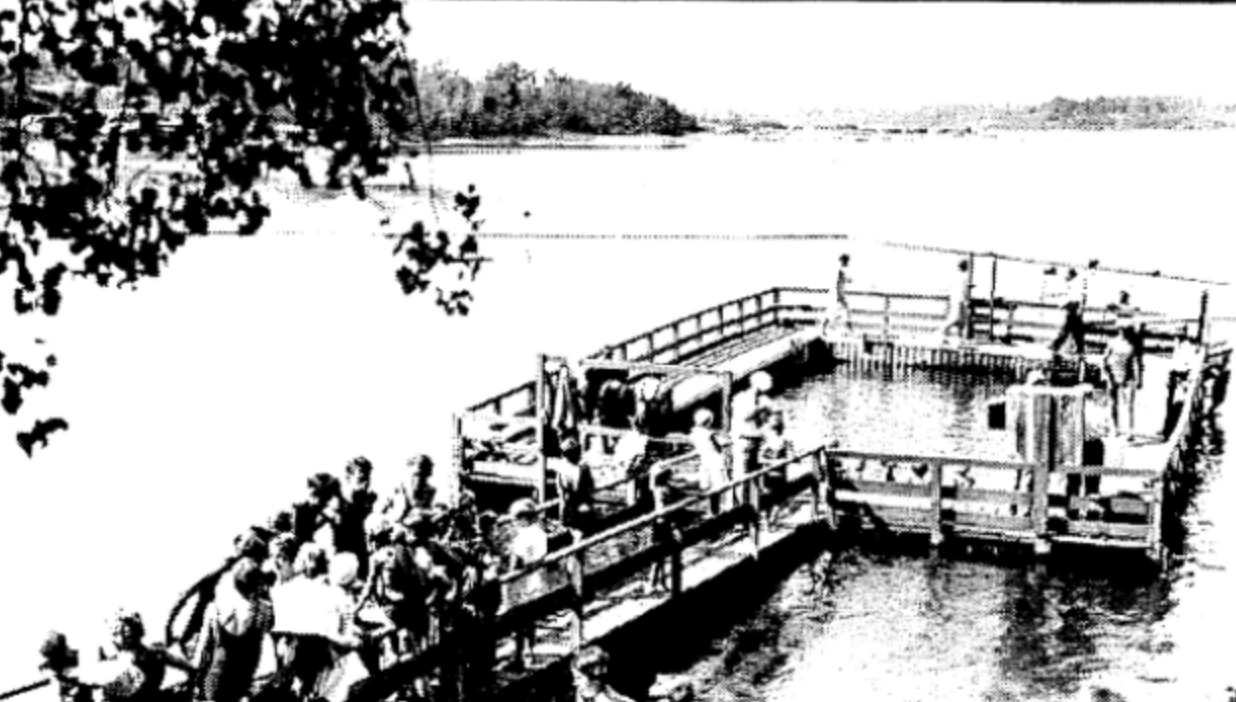
William J. Gresham (1903-1978), who served as principal of the Pine Falls School during its formative days,2 wore a second hat as supervisor and lifeguard of the floating pool through 1932. Not surprisingly, curiosity got the better of some swimmers and Mr. Gresham occasionally found himself rescuing children and youth who had swam beyond their depths – either within the pool structure itself, or in the Winnipeg River after having jumped or fallen from the wooden railing designed to keep pool patrons safe. In 1929, Mr. Gresham lost his shoes in the river while diving from the lifeboat provided for rescue purposes, but managed to save the life of a young boy named Gerald Elliot.3
Despite the risks associated with its location, the floating pool would serve the community for over two decades. Efforts were already underway in the late 1940s to build a new recreational centre for winter sports, and it seemed logical to revamp the town’s swimming facilities, too. Thus in the summer of 1951 did a new swimming and wading pool open for use not far from the arena opened a year and a half prior. Constructed under the auspices of the Manitoba Paper Company, it cost $6,000 to build with some 1,000 hours of volunteer labour provided by the local Trades and Labour Council.4
Always looking for ways to improve and enhance the community, the Labour Council oversaw the construction of yet another pool in 1984. Located at the northeast corner of Walnut and Oak Streets, it was paid for partly by subscription and overshadowed its predecessors in size.
From hosting children’s swimming events sponsored by the Labour Council, to bidding residents and visitors to take a dip on the most scorching of summer days, this in-ground pool (complete with change houses) has carried on a long tradition of recreational swimming in Pine Falls.5
25. Empower

ca. 1930s
Now home to Empower Sunrise Adult Learning Programs, the unassuming building at the northeast corner of Oak and Walnut Streets was originally built for the Royal Canadian Legion branch. The Legion did not have a home of its own until after the Second World War, and like other institutions in Pine Falls – notably, the churches and arena – its growth and development dictated the need for a new meeting-place by the 1950s.
* * *
The Legion moved closer to downtown Pine Falls in the early 1950s, and for the last several years the old hall has been home to Empower, a facility offering academic upgrading; career counselling; courses in partnership with post-secondary institutions; prior learning assessment and recognition (PLAR) information and advice; and online courses to foster and facilitate working from home. A provincial food handlers course is also offered on an as-needed, scheduled basis.
Whether fostering fellowship among those who served in the past, or empowering the leaders of tomorrow, this unembellished building has long played an important role in the life of Pine Falls.
Endnotes
1. The Fire Hall
1. “Nissen hut,” Wikipedia: The Free Encyclopedia.
2. Dess Trudell, “The Village of Powerview, From 1951 to 1988,” in *From the Beaches to the Falls: A Winnipeg River-Lake Winnipeg Heritage, Manitoba, Canada,* ed. D. Trudell (Powerview-Pine Falls: Winnipeg River Historical Project, 1989), 164.
2. Wings of Power
1. Dess Trudell, “Life Along The Winnipeg River,” in *From the Beaches to the Falls: A Winnipeg River-Lake Winnipeg Heritage, Manitoba, Canada,* ed. D. Trudell (Powerview-Pine Falls: Winnipeg River Historical Project, 1989), 10.
2. George Bayley, “Construction Begins,” in The First Years: A History Celebrating The 75th Anniversary of Paper Production in the Town of Pine Falls, ed. G. Bayley (Powerview-Pine Falls: George Bayley, 2002), 3.
3. The Post Office
1. B. Rotoff, “Pine Falls: Garden City In The Wilderness,” (unpublished article, Faculty of Architecture, University of Manitoba), 3.
2. Myrtle Mackie, “Pine Falls Post Office,” in From the Beaches to the Falls: A Winnipeg River-Lake Winnipeg Heritage, Manitoba, Canada, ed. D. Trudell (Powerview-Pine Falls: Winnipeg River Historical Project, 1989), 134-135.
4. Pine Plaza
1. Dess Trudell, “Manitoba Paper Company’s Mercantile Store,” in From the Beaches to the Falls: A Winnipeg River-Lake Winnipeg Heritage, Manitoba, Canada, ed. D. Trudell (Powerview-Pine Falls: Winnipeg River Historical Project, 1989), 133-134
2. Fleming, R.B. General Stores of Canada: Merchants and Memories. Toronto: Lynx Images, 2002.
3. Trudell, “Manitoba Paper Company’s Mercantile Store,” 134
6. The Legion
1. Red Halpin, “Royal Canadian Legion Branch No. 64, Pine Falls” in From the Beaches to the Falls: A Winnipeg River-Lake Winnipeg Heritage, Manitoba, Canada, ed. D. Trudell (Powerview-Pine Falls: Winnipeg River Historical Project, 1989), 141-142.
2. Halpin, 142.
3. Annie Patterson and Freda Stewart, “Ladies’ Legion Auxiliary, Pine Falls Branch No. 64” in From the Beaches to the Falls: A Winnipeg River-Lake Winnipeg Heritage, Manitoba, Canada, ed. D. Trudell (Powerview-Pine Falls: Winnipeg River Historical Project, 1989), 143.
7. The Locomotive
1. Anne Cavers, “History of Pine Falls,” in From the Beaches to the Falls: A Winnipeg River-Lake Winnipeg Heritage, Manitoba, Canada, ed. D. Trudell (Powerview-Pine Falls: Winnipeg River Historical Project, 1989), 114.
2. B. Rotoff, “Pine Falls: Garden City In The Wilderness,” (unpublished article, Faculty of Architecture, University of Manitoba), 8.
3. Train Station, Pine Falls [photograph], PF097, Winnipeg River Heritage Museum
4. Unknown, Early Days In Pine Falls, Abitibi Paper Co. Ltd. (Pine Falls: Abitibi Paper Co. Ltd., 1976), 9.
5. “Industrial Steam Locomotives (Other Than Ontario),” Old Time Trains, last updated 2009, http://www.trainweb.org/oldtimetrains/photos/logging/steam.htm
6. Steve Boyko, “CEMR Pine Falls Subdivision Report,” Confessions of a Train Geek (blog) 5 May 2013, https://blog.traingeek.ca/2013/05/cemr-pine-falls-subdivision-report.html
7. Robin Summerfield, “Abandoned train engine listed on Kijiji for $25,000,” CBC News, last updated August 30 2016, https://www.cbc.ca/news/canada/manitoba/train-engine-pine-falls-for-sale-kijiji-1.3740166
8. Manitou Lodge
1. Obituary, “Gordon Mulligan” The Winnipeg Tribune, April 7 1978, Pg. 21
2. Advertisement, The Winnipeg Evening Tribune, August 28 1952, Pg. 13
3. Advertisement, The Winnipeg Evening Tribune, July 31 1952, Pg. 26
4. “C.N.R. Ladies Hold Windup,” The Winnipeg Evening Tribune, September 25 1953, Pg. 23
5. “Management courses offered businessmen,” The Winnipeg Tribune, December 30 1966, Pg. 18
6. Advertisement, The Winnipeg Evening Tribune, September 20 1956, Pg. 36
7. “Duff Has Secret Session At Lodge,” The Winnipeg Tribune, January 21 1961, Pg. 1
8. Advertisement, The Winnipeg Tribune, February 28 1970, Pg. 33
9. Harry Rowe, “Pine Falls Police Force,” in From the Beaches to the Falls: A Winnipeg River-Lake Winnipeg Heritage, Manitoba, Canada, ed. D. Trudell (Powerview-Pine Falls: Winnipeg River Historical Project, 1989), 141.
9. The Chateau
1. Cavers, “History of Pine Falls,” in From the Beaches to the Falls: A Winnipeg River-Lake Winnipeg Heritage, Manitoba, Canada, ed. D. Trudell (Powerview-Pine Falls: Winnipeg River Historical Project, 1989), 117-118.
2. “Motion Picture Theatres In Canada, 1939,” published by Authority of the Hon. James A. MacKinnon, M.P., Minister of Trade and Commerce (Ottawa: Dominion Bureau of Statistics, 1940), 2,4,9
3. Harold Loster, “Around The Head Pin,” The Winnipeg Tribune, March 27 1974, Pg. 17
4. “Community Meet,” The Winnipeg Evening Tribune, April 5 1941, Pg. 20
5. “Pine Falls College Students Graduate,” The Winnipeg Tribune, June 11 1948, Pg. 8
6. Cavers, “History of Pine Falls,” in From the Beaches to the Falls: A Winnipeg River-Lake Winnipeg Heritage, Manitoba, Canada, ed. D. Trudell (Powerview-Pine Falls: Winnipeg River Historical Project, 1989), 119.
7. “Mark Diamond Wedding Anniversary,” The Winnipeg Evening Tribune, January 16 1960, Pg. 15
8. Cavers, “History of Pine Falls,” in From the Beaches to the Falls: A Winnipeg River-Lake Winnipeg Heritage, Manitoba, Canada, ed. D. Trudell (Powerview-Pine Falls: Winnipeg River Historical Project, 1989), 119.
10. Elm and Tamarac
1. Cavers, “History of Pine Falls,” in From the Beaches to the Falls: A Winnipeg River-Lake Winnipeg Heritage, Manitoba, Canada, ed. D. Trudell (Powerview-Pine Falls: Winnipeg River Historical Project, 1989), 118.
2. Cavers, “History of Pine Falls,” in From the Beaches to the Falls: A Winnipeg River-Lake Winnipeg Heritage, Manitoba, Canada, ed. D. Trudell (Powerview-Pine Falls: Winnipeg River Historical Project, 1989), 119
3. Dave Adams, “Pine Falls Races Snowfall, Hastens Recreation Centre,” The Winnipeg Tribune, October 5 1949, Pg. 3
4. ibid The Winnipeg Tribune, October 5 1949, Pg. 3
5. Cavers, “History of Pine Falls,” in From the Beaches to the Falls: A Winnipeg River-Lake Winnipeg Heritage, Manitoba, Canada, ed. D. Trudell (Powerview-Pine Falls: Winnipeg River Historical Project, 1989), 120-121.
11. Poplar and Cedar
1. “Bill Watson (ice hockey)” Wikipedia: The Free Encyclopedia
2. Ashley Prest, “Sharpe set to cut himself out, Promises family 2010 is last year in boxing,” The Winnipeg Free Press, July 6 2010, online.
12. Cherry and Birch
1. Marcel Pitre, Pine Falls, Placing Our Minds In Reverse: A Morsel Of Life As It Was. 2005. Pgs. 60-63, 66.
2. Email from H. Chevrefils, December 16, 2022.
3. “Bill Watson (ice hockey)” Wikipedia: The Free Encyclopedia
4. Ashley Prest, “Sharpe set to cut himself out, Promises family 2010 is last year in boxing,” The Winnipeg Free Press, July 6 2010, online.
13. The Village Green
1. Anonymous, “Baseball diamond named after Leonard Rupert,” in From the Beaches to the Falls: A Winnipeg River-Lake Winnipeg Heritage, Manitoba, Canada, ed. D. Trudell (Powerview-Pine Falls: Winnipeg River Historical Project, 1989), 154.
2. George Bayley, “Around town with news, sports, and social notes, 1929-30,” in The First Years: A History Celebrating The 75th Anniversary of Paper Production in the Town of Pine Falls, ed. G. Bayley (Powerview-Pine Falls: George Bayley, 2002), 24.
3. Bayley, “Silent Machines,” in The First Years: A History Celebrating The 75th Anniversary of Paper Production in the Town of Pine Falls, ed. G. Bayley (Powerview-Pine Falls: George Bayley, 2002), 30.
4. “Sandy Weir,” Manitoba Golf Hall of Fame, Golf Manitoba, https://www.golfmb.ca/articles/tag/manitoba-golf-hall-of-fame/
5. Herb Manning, “Alex Weir Wins Northeastern Open Title, Veteran Shoots 73 At Pine Falls,” The Winnipeg Evening Tribune, August 23 1943, Pg. 12
6. “C.N.R. Ladies Hold Windup,” The Winnipeg Evening Tribune, September 25 1953, Pg. 23
7. Bayley, “Around town with news, sports, and social notes, 1929-30,” in The First Years: A History Celebrating The 75th Anniversary of Paper Production in the Town of Pine Falls, ed. G. Bayley (Powerview-Pine Falls: George Bayley, 2002), 24.
14. Church of the Advent
1. “American Craftsman,” Wikipedia: The Free Encyclopedia, https://en.wikipedia.org/wiki/American_Craftsman
2. Unknown, “The Church Of The Advent Parish Of Pine Falls (Anglican),” in From the Beaches to the Falls: A Winnipeg River-Lake Winnipeg Heritage, Manitoba, Canada, ed. D. Trudell (Powerview-Pine Falls: Winnipeg River Historical Project, 1989), 204-205.
3. “Ordinations and Service” in A Tribute to Steadfast Service: St. John’s Anglican Church at 100, The Rev’d. Brian Rountree (Lac du Bonnet: St. John’s Anglican Church, 2006), 11
4. ibid, 11
15. Sunnywood Hospital
1. Marium Frayne, “Short History Of The Pine Falls Hospital Auxiliary,”in From the Beaches to the Falls: A Winnipeg River-Lake Winnipeg Heritage, Manitoba, Canada, ed. D. Trudell (Powerview-Pine Falls: Winnipeg River Historical Project, 1989), 135-136.
2. Frayne, 135-136.
17. Beautiful Homes on Balsam
1. J. P. Mertz, “The Planning of Pine Falls, Manitoba: A Model Industrial Town,” Journal of the Town Planning Institutes (June 1929), pg. 47, quoted in Robert Robson, “Manitoba’s Resource Towns: The Twentieth Century Frontier,” Institute of Urban Studies, University of Winnipeg, printed in Manitoba History, Number 16, Autumn 1988.
2. From the poem Jerusalem, by William Blake (1757-1827)
3. Robson, “Manitoba’s Resource Towns: The Twentieth Century Frontier,” Institute of Urban Studies, University of Winnipeg, printed in Manitoba History, Number 16, Autumn 1988.
4. ibid, Robson.
5. ibid, Robson.
21. The Mill Manager’s House
1. “Last Respects Paid To Charles C. Irvine,” The Winnipeg Evening Tribune, December 27 1945, 1
2. George Bayley, “The Townsite,” in The First Years: A History Celebrating The 75th Anniversary of Paper Production in the Town of Pine Falls, ed. G. Bayley (Powerview-Pine Falls: George Bayley, 2002).
3. Bayley, “Around town with news, sports, and social notes 1929-30,” inThe First Years: A History Celebrating The 75th Anniversary of Paper Production in the Town of Pine Falls.
4. Harry Rowe, “Pine Falls Police Force,” in From the Beaches to the Falls: A Winnipeg River-Lake Winnipeg Heritage, Manitoba, Canada, ed. D. Trudell (Powerview-Pine Falls: Winnipeg River Historical Project, 1989), 141.
22. Pine Falls United Church
1. Unknown, “Churches: Historical Notes,” in From the Beaches to the Falls: A Winnipeg River-Lake Winnipeg Heritage, Manitoba, Canada, ed. D. Trudell (Powerview-Pine Falls: Winnipeg River Historical Project, 1989), 203-204.
2. “Memorable Manitobans: John King Gordon (1900-1989),” Manitoba Historical Society, last modified June 27 2015, http://www.mhs.mb.ca/docs/people/gordon_jk.shtml
3. Unknown, “Churches: Historical Notes,” in From the Beaches to the Falls: A Winnipeg River-Lake Winnipeg Heritage, Manitoba, Canada, ed. D. Trudell (Powerview-Pine Falls: Winnipeg River Historical Project, 1989), 204.
23. Pine Falls School
1. Unknown, “Pine Falls School 1926 To 1985,” in From the Beaches to the Falls: A Winnipeg River-Lake Winnipeg Heritage, Manitoba, Canada, ed. D. Trudell (Powerview-Pine Falls: Winnipeg River Historical Project, 1989), 160-162.
2. ibid, 160-162
3. “Memorable Manitobans: Howard Melville Dunfield (1912-2000),” Manitoba Historical Society, last modified June 11 2017, http://www.mhs.mb.ca/docs/people/dunfield_hm.shtml
24. The Swimming Pool
1. J. Dulake, “Memories of Jack Dulake,” in From the Beaches to the Falls: A Winnipeg River-Lake Winnipeg Heritage, Manitoba, Canada, ed. D. Trudell (Powerview-Pine Falls: Winnipeg River Historical Project, 1989), 133.
2. “Memorable Manitobans: William Jonathan Gresham (1903-1978),” Manitoba Historical Society, last modified June 26 2022, http://www.mhs.mb.ca/docs/people/gresham_wj.shtml
3. George Bayley, “River Tales of 1929,” in The First Years: A History Celebrating The 75th Anniversary of Paper Production in the Town of Pine Falls, ed. G. Bayley (Powerview-Pine Falls: George Bayley, 2002).
4. Cavers, “History of Pine Falls,” in From the Beaches to the Falls: A Winnipeg River-Lake Winnipeg Heritage, Manitoba, Canada, ed. D. Trudell (Powerview-Pine Falls: Winnipeg River Historical Project, 1989), 120.
5. Cavers, 121.
Bibliography
Bayley, George. The First Years: A History Celebrating The 75th Anniversary of Paper Production in the Town of Pine Falls. Powerview-Pine Falls: George Bayley, 2002.
MacKinnon, James A. Motion Picture Theatres in Canada, 1939. Ottawa: Dominion Bureau of Statistics, 1940.
Robson, Robert. “Manitoba’s Resource Towns: The Twentieth Century Frontier.” Institute of Urban Studies. University of Winnipeg, printed in Manitoba History, Number 16, Autumn 1988.
Rotoff, B. “Pine Falls: Garden City In The Wilderness." Unpublished article, Faculty of Architecture, University of Manitoba.
Trudell, Dess. From the Beaches to the Falls: A Winnipeg River-Lake Winnipeg Heritage, Manitoba, Canada, ed. D. Trudell. Powerview-Pine Falls: Winnipeg River Historical Project, 1989..



